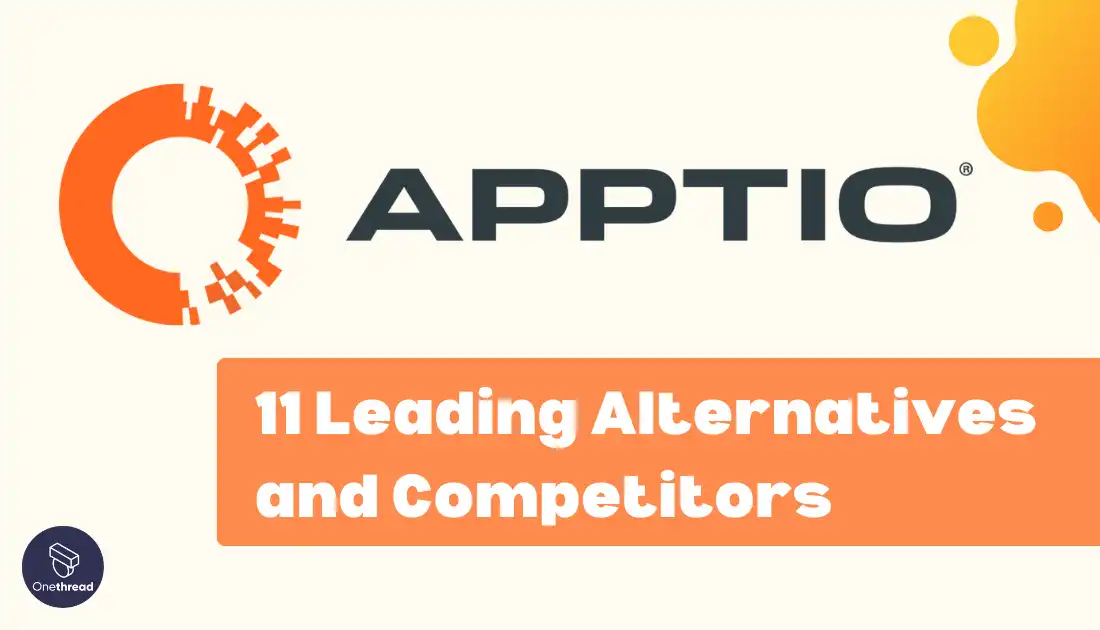Struggling with Apptio’s complexity and rising costs? Seeking more flexibility and user-friendly alternatives aligned to your needs? You’re not alone. From performance issues to limited customization, many organizations are now exploring options beyond Apptio for IT financial management. This article outlines the top Apptio alternatives based on key criteria
Quick List of The Best 11 Apptio Alternatives
- IBM Turbonomic: Best Apptio alternative for assured cloud optimization and application performance.
- BetterCloud: Best for SaaS visibility, security, and workflow automation.
- Vendr (Formerly Blissfully): Best for streamlining SaaS and cloud purchasing workflows.
- Nicus ITFM Suite: Best alternative to Apptio for collaborative IT financial planning tailored to all stakeholders.
- Flexera: Best for complete hybrid IT optimization beyond financials.
- Azure Cost Management: Best for Microsoft cloud cost governance and accountability.
- CloudCheckr (Formerly Cloud Analyzer): Best for cloud utilization efficiency via precision analytics.
- VMware Tanzu CloudHealth: Best for multi-cloud cost, security, and operations management.
- Bee360: Best for intuitive IT financial analytics across hybrid environments.
- CloudZero: Best one to choose over Apptio for engineering teams to understand cloud cost drivers.
- CIO Cockpit Business: Best for real-time financial insights into vendors and SaaS apps.
Our reviewers evaluate software independently. Clicks may earn a commission, which supports testing. Learn how we stay transparent & our review methodology
What is Apptio?
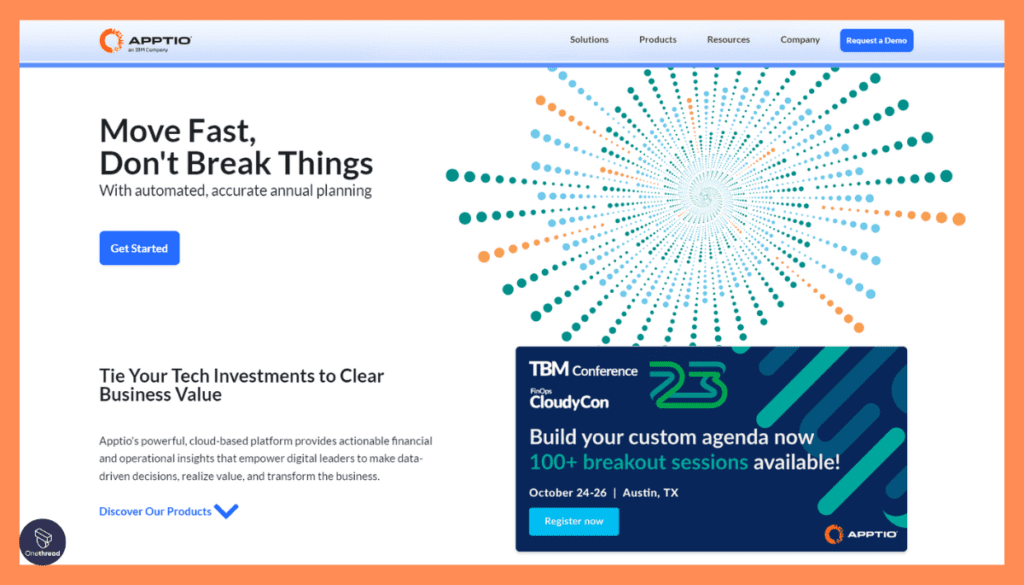
Apptio is a Technology Business Management (TBM) software company. It provides tools that help businesses analyze and plan their IT spending. Founded in 2007, Apptio’s software helps organizations understand their cost structure and make informed decisions.
The tool structure includes various modules such as cost transparency, IT benchmarking, and business insights. These features enable businesses to analyze spending, compare against industry standards, and derive value from their IT investments.
The benefits include cost savings, improved efficiency, and alignment of IT strategies with business goals. Requirements for using Apptio may vary based on the specific needs and scale of the organization.
Reasons To Consider An Alternative To Apptio: Apptio Cons
Apptio users frequently face issues with the platform’s complexity, unintuitive interface, performance problems causing slowdowns and latency, limited customization around dashboards and metrics, data and reporting constraints, lack of advanced analytics, challenging onboarding, and upgrades, inadequate support and documentation, and overall cost-effectiveness – leading organizations to explore alternatives that are simpler, more flexible, performant, and provide greater value.
Let’s have a look at the major drawbacks of Apptio in detail.
- Complexity and User-Unfriendly Interface: The interface of Apptio is often complex and not intuitive, posing challenges in accessing and understanding data easily.
- Inconsistent Reporting and Layouts: Apptio’s reporting surface can be overwhelming due to inconsistencies in appearance and functionality across different reports, leading to confusion.
- Performance Issues: There are frequent experiences of slowdowns and non-responsiveness in ApptioOne, particularly in the TBM Studio module, causing inefficiencies and frustration.
- Limited Customization and Flexibility: Customization options in Apptio, including report colors, text, and dashboard layouts, are often rigid and limited.
- Cloudability’s Limited Features: Apptio’s Cloudability offers a restricted range of features, especially in areas like graphics customization, dashboard governance, and support for various cloud providers.
- Data and Reporting Limitations: There are notable constraints in data collection and reporting capabilities, often requiring external tools for additional data manipulation.
- Challenges in Initial Setup and Integration: The initial setup process, particularly cloud account onboarding and API integration, is generally cumbersome and prone to errors.
- Software Latency and Calculation Delays: In Apptio, complex reporting structures lead to significant calculation delays and software latency, impacting overall efficiency.
- Lack of Predictive and Advanced Analytics: There is a notable absence of advanced analytics features, such as linear regression for predictive budgeting and the option for longer analytical windows.
- Difficulty in Navigating and Training: Navigating through Apptio’s options can be challenging for new individuals, requiring significant training for effective utilization.
- Inadequate Support and Documentation: The API and technical support tend to be underwhelming, with issues in documentation and delayed assistance.
- Cost-Effectiveness and ROI Concerns: Considering its complexities and limitations, there might be doubts about the cost-effectiveness and return on investment of Apptio, prompting the exploration of alternatives.
Best 11 Apptio Competitors: Comparison Chart
Below is a comparison chart that outlines the top 11 Apptio competitors:
Software | Ease of Use | IT Financial Analytics | Cloud Management | Flexible Pricing | Integration Capabilities |
 | Steep learning curve, Unintuitive interface | Advanced predictive analytics and modeling | AWS, Azure, and GCP support | Custom enterprise pricing | APIs and data integrations |
 | Intuitive dashboards, May require training for some modules | Advanced analytics and ML-driven insights | Optimizes costs across multi-cloud | Premium pricing model | APIs and CLI for integration |
 | Extremely intuitive | Basic IT spend analytics | SaaS governance and security | Free and premium tiers | Range of integrations |
 | Very user-friendly | Standard spend analytics | Limited capabilitiesNo | Scalable subscription plans | Wide range of integrations |
 | Customizable views tailored to users | Financial planning aligned with business | NA | Not publicly disclosed | Integration capabilities unknown |
 | Dashboard and data modules are complex | Usage and license analytics | Cross-cloud optimization | Quotes provided based on needs | APIs and flat file exchange |
 | Embedded within Azure Portal | Cost and usage analytics | Specialized for Azure cloud | Free for Azure management | Native Azure integration |
 | Learning curve for some features | Analytics-focused cloud optimization | Visibility across cloud accounts | Premium tiers | Cloud provider API integration |
 | Intuitive multi-cloud views | Actional analytics on cloud costs | Unified optimization for multi-cloud | Tiered based on cloud spend under management | Range of native cloud integrations |
 | Extremely easy-to-use | Advanced AI-driven analytics | Cost tracking across cloud accounts | Packaged pricing tiers | APIs and flat file import options |
 | Intuitive dashboards tailored for engineering teams | Real-time cloud cost analytics | Cloud cost intelligence across providers | Subscription plans | Integration with cloud providers |
 | Customizable dynamic dashboards | Predictive modeling for budgets | Real-time SaaS and vendor cost tracking | Custom enterprise pricing | Seamless data integration from multiple sources |
1. IBM Turbonomic
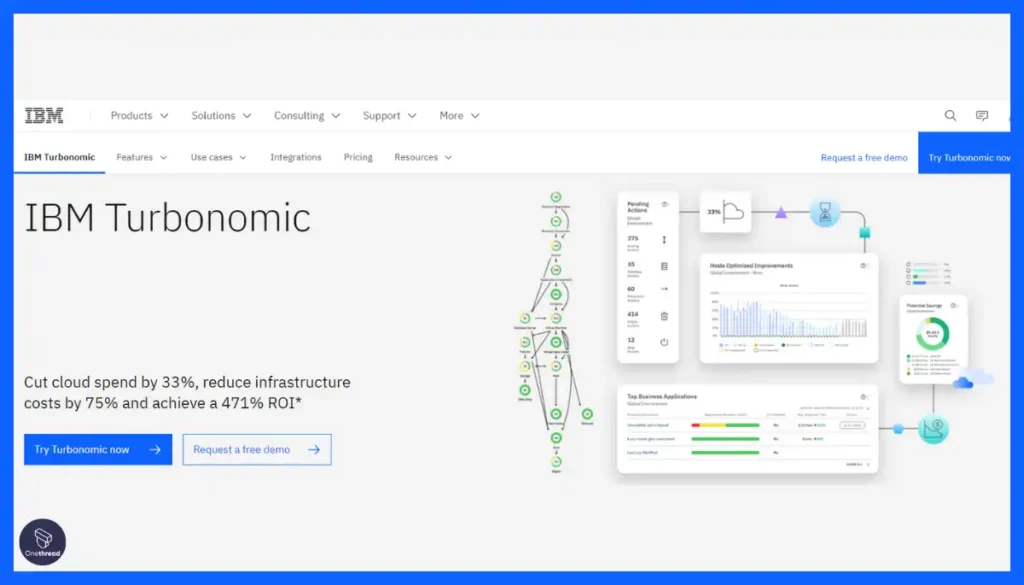
IBM Turbonomic is the best Apptio alternative for organizations seeking simplified IT financial management. Unlike Apptio’s complex and unintuitive interface, IBM Turbonomic provides intuitive visibility and control across multi-cloud environments to optimize costs and assure application performance.
With its top-down approach spanning from applications to infrastructure, IBM Turbonomic stitches together interdependencies for greater collaboration and accurate decision-making. It also features trusted, continuous automation rather than the manual configurations often required in Apptio. This enables efficient resource allocation in real time without performance risks or revenue impacts.
Additionally, IBM Turbonomic differs from Apptio with its focus on driving real business outcomes and ROI through precise, preemptive actions. The platform prevents overprovisioning and cloud waste through proactive recommendations. With rapid time-to-value and easy integration, organizations can overcome Apptio’s steep learning curves and quickly realize optimized efficiency.
Key Features of IBM Turbonomic
IBM Turbonomic features industry-leading capabilities for optimization that conquer Apptio’s limitations:
Full Stack Visibility:
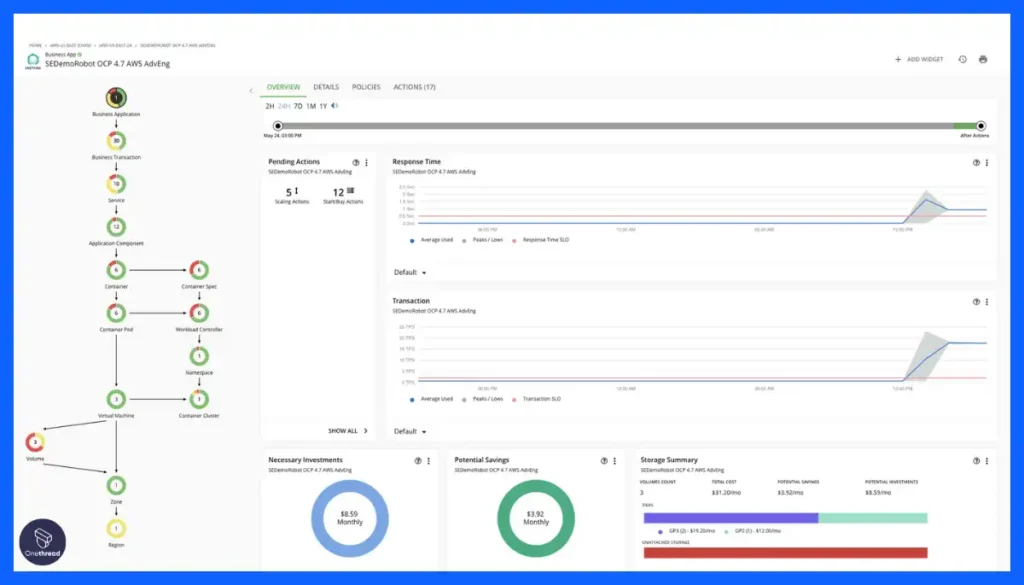
Stitches together how business-critical applications depend on underlying infrastructure components like virtual machines and storage at every layer to increase collaboration and enable cost-optimized provisioning decisions.
Automated Actions:
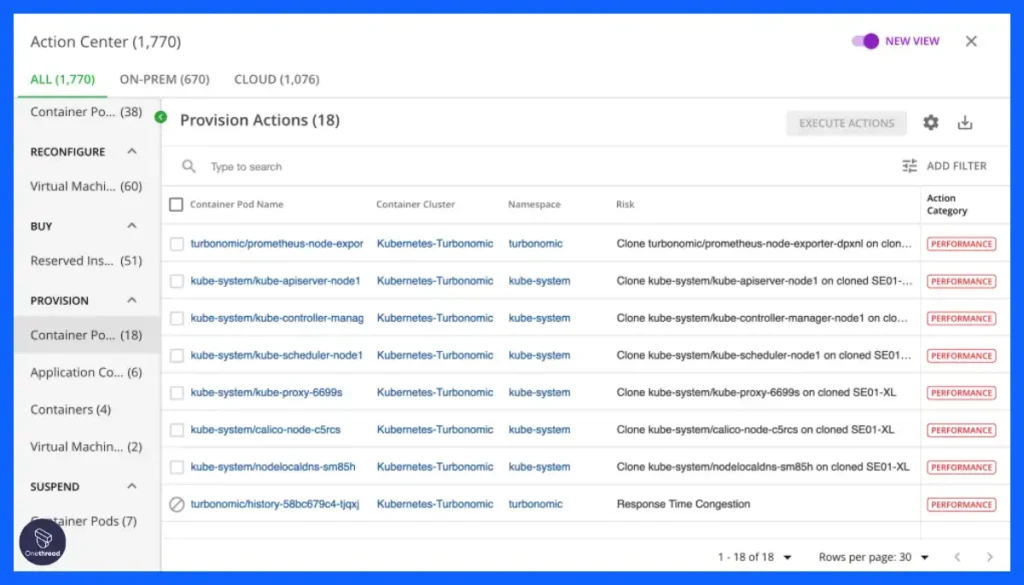
Intelligently and continuously executes recommended resourcing actions to optimize performance and costs without needing human intervention, enabling speed, elasticity, and mitigating performance risks.
Multicloud Support:
Manages multiple public clouds like AWS, Azure, and GCP along with private clouds from a single platform, optimizing costs across hybrid cloud environments while assuring performance.
Unified Data Model:
Provides a shared vocabulary and understanding that aligns application, infrastructure, and financial teams for improved planning, forecasting, and decision-making.
Focus on Outcomes:
Goes beyond infrastructure metrics to quantify the impact on key performance indicators like transaction volume and revenue for each application to justify investments.
Easy Integration:
Offers open APIs and a rich ecosystem of technology partners to enable quick and seamless integrations with existing tools across various stacks to accelerate time-to-value.
Pros of IBM Turbonomic
- Provides full-stack visibility into applications and infrastructure
- Continuously optimizes resource allocation in real-time
- Avoids overprovisioning to reduce costs
- Assures application performance
- Manages hybrid and multi-cloud environments
- Rapid time to value with seamless integrations
Cons of IBM Turbonomic
- Can have a steep learning curve
- Limited custom reporting capabilities
- Lacks advanced analytics and forecasting functionalities
IBM Turbonomic Pricing Plans
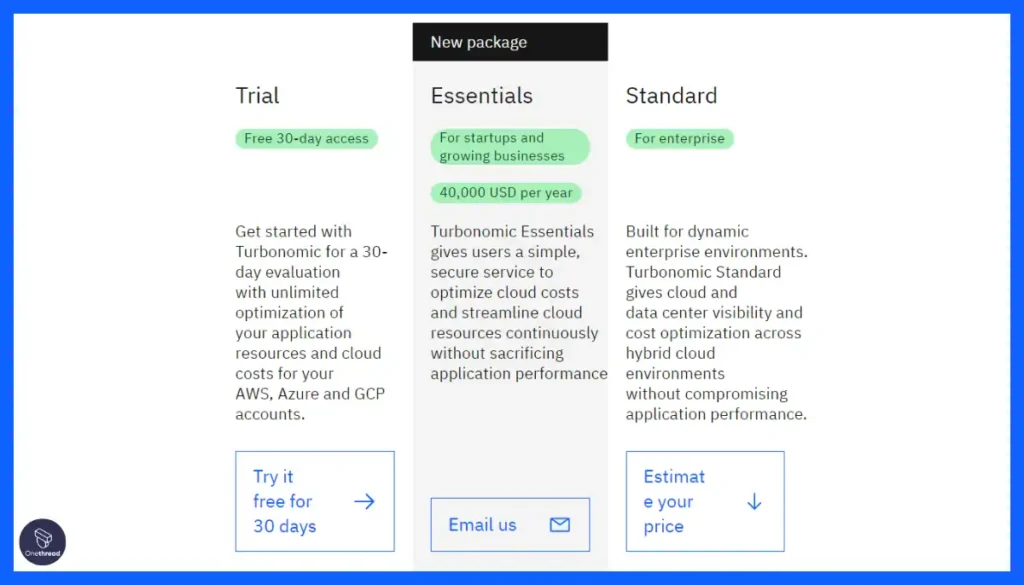
- Trial: Free 30-day trial
- Essentials: $40,000 per year
- For startups and growing businesses
- Optimizes cloud costs and resources
- Standard: Priced per Managed Virtual Server
- For enterprise
- Gives hybrid cloud visibility and optimization
What Users Say About IBM Turbonomic?
Review on G2: 4.5 out of 5
“What do you like best about IBM Turbonomic?
IBM Turbonomic optimizes and facilitates the efficient use of resources within organizations, helping to reduce costs and improving application performance. Resilience and security are increased from the first moment the tool is implemented, promoting the intelligent use of infrastructures. The productivity of our employees is increased since the automation of tasks reduces the workload within the operational processes.
What do you dislike about IBM Turbonomic?
Being a fairly complex solution it can be difficult to configure, however, it is worth it as it is such a powerful tool for resource utilization and process improvement. It should be verified beforehand if it is compatible with your process structure since it is not compatible with all of them. It requires qualified personnel that can operate the tool due to the complexity of the tool, promoting perhaps an extra expense in training within the employees.”- Sylvia D. H.
Is IBM Turbonomic Better Than Apptio?
IBM Turbonomic surpasses Apptio if you require simplified multi-cloud optimization and assured application performance. With its trusted automation and focus on driving business outcomes, IBM Turbonomic is the superior choice for organizations struggling with Apptio’s manual configurations and narrow IT financial analytics.
However, Apptio provides more tailored IT financial management capabilities for some specialized needs. Its TBM module remains an industry benchmark for complex chargeback and showback reporting not matched by IBM Turbonomic.
2. BetterCloud
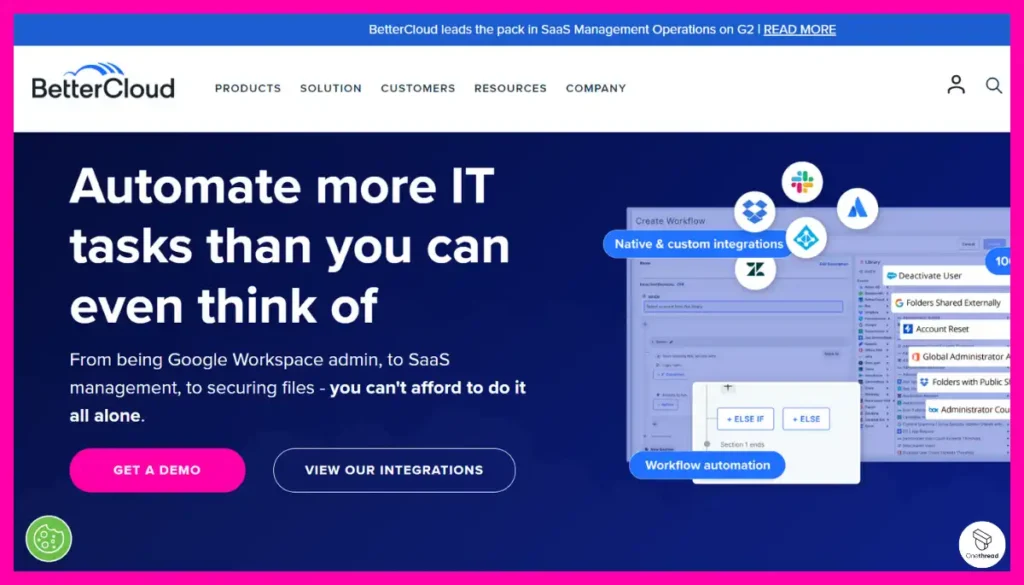
For organizations seeking enhanced SaaS management capabilities beyond what Apptio offers, BetterCloud is a leading alternative worth considering. With intuitive features for automated SaaS operations, BetterCloud helps overcome Apptio’s complexity through simplified workflows.
BetterCloud enables zero-touch user lifecycle automation and day-to-day SaaS management. This eliminates the tedious manual processes often required in Apptio implementations. BetterCloud also centralizes control and visibility for an organization’s entire SaaS landscape, mitigating Apptio’s data silos and governance gaps.
Additionally, BetterCloud proactively protects sensitive SaaS data through automated policy enforcement. This strengthens security and compliance, addressing common risks resulting from Apptio’s intricate configurations. With BetterCloud, enterprises can confidently offboard employees while avoiding negative impacts on productivity.
While IBM Turbonomic may have an edge in infrastructure optimization, BetterCloud shines as an Apptio alternative focused purely on streamlining an organization’s critical SaaS operations. For SaaS-centric environments struggling with Apptio’s limitations, BetterCloud warrants strong consideration.
Key Features of BetterCloud
BetterCloud provides intuitive SaaS management features making it a compelling Apptio alternative:
Comprehensive Discovery:
Gains complete visibility across all SaaS applications to manage shadow IT risks, consolidate spending, and improve cross-team collaboration.
End-to-End Lifecycle Automation:
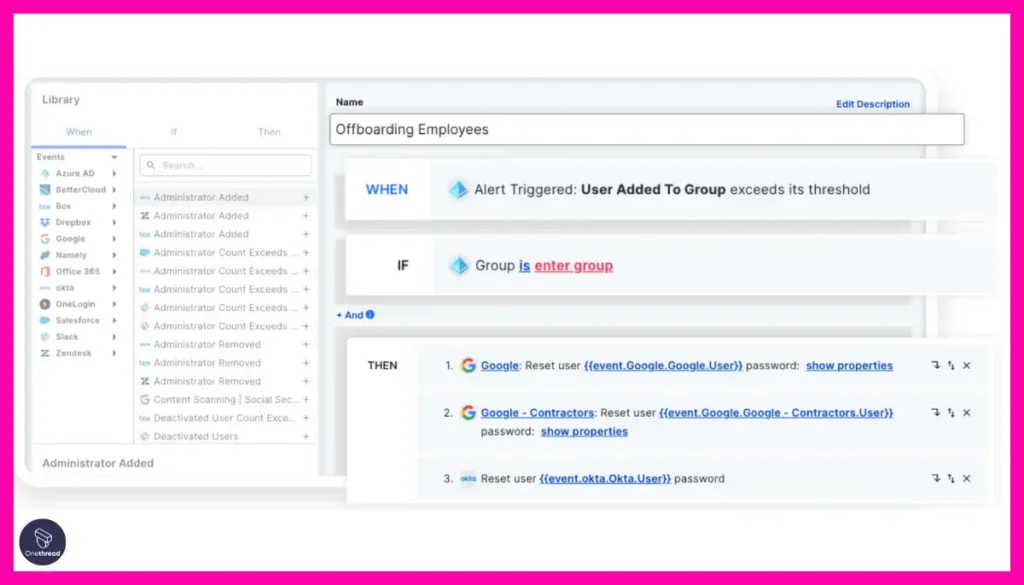
Automatically manages mundane user onboarding, offboarding, licensing, and operations workflows across SaaS apps.
Unified SaaS Management:
Centrally oversees security, compliance, operations, and financials for simplified, optimized SaaS management.
Sensitive Data Protection:
Discovers, classifies, and secures sensitive or regulated data stored in SaaS applications to reduce breach risks.
Custom Workflows:
Builds customizable workflows with approvals, conditional logic, and app integrations tailored to an organization’s policies.
Actionable Intelligence:
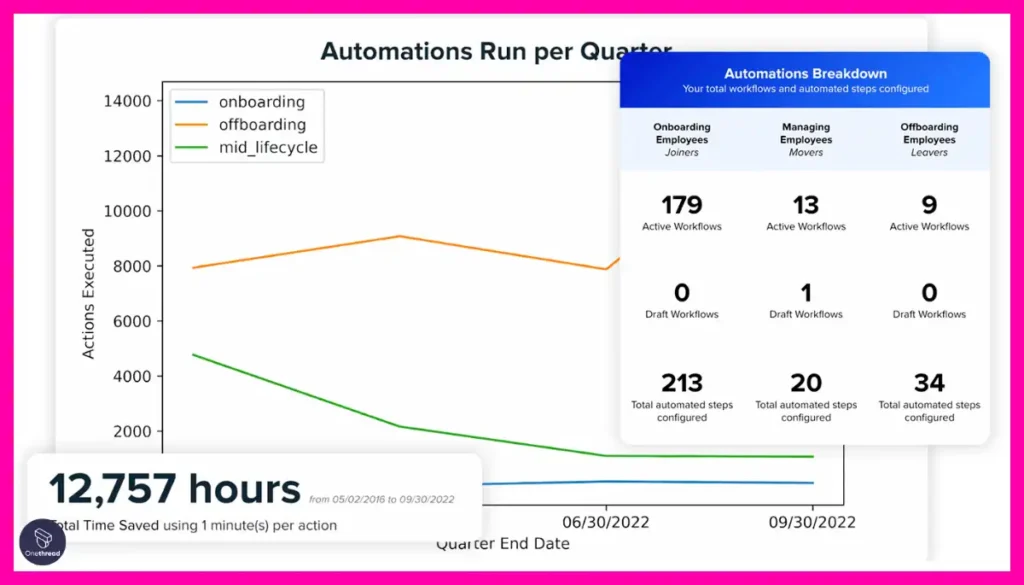
Offers data-driven SaaS intelligence for risk exposure, license utilization, and spend optimization to inform better decisions.
Pros of BetterCloud
- Automates management of SaaS applications
- Identifies and remediates risky access
- Consolidates redundant apps and licenses
- Secures and protects sensitive SaaS data
- Ensures compliance visibility
- Zero-touch lifecycle management workflows
BetterCloud Pricing Plans
- Free: Free version with limited capabilities
- Premium: Custom pricing
- Full access to BetterCloud platform
- Advanced features and integrations
Cons of BetterCloud
- Mostly focused on SaaS apps, lacks insight into infrastructure
- Additional modules and integrations increase complexity
- Can be expensive for smaller businesses
What Users Say About BetterCloud?
Review on G2: 4.4 out of 5
“What do you like best about BetterCloud?
The reports are great, and being able to tackle additional tasks like email signatures is a significant bonus. Overall the features presented work well and serve the purpose.
The product continues to improve and we’re glad to have it available to us
What do you dislike about BetterCloud?
I’ve run into a couple of issues with reports and certainly look forward to them adding more functionality too.
I’ve had a couple of times where the sync doesn’t seem consistent.”- Justin W.
Is BetterCloud Better Than Apptio?
BetterCloud is the better option over Apptio for SaaS-centric enterprises seeking enhanced SaaS visibility, governance, and lifecycle automation. With streamlined user management workflows and proactive data security, BetterCloud addresses common Apptio limitations around fragmented SaaS operations and risk management.
But Apptio still leads for advanced IT cost analytics across complex hybrid infrastructure. Its financial insights surpass the operational focus of BetterCloud.
3. Blissfully (Currently Vendr)
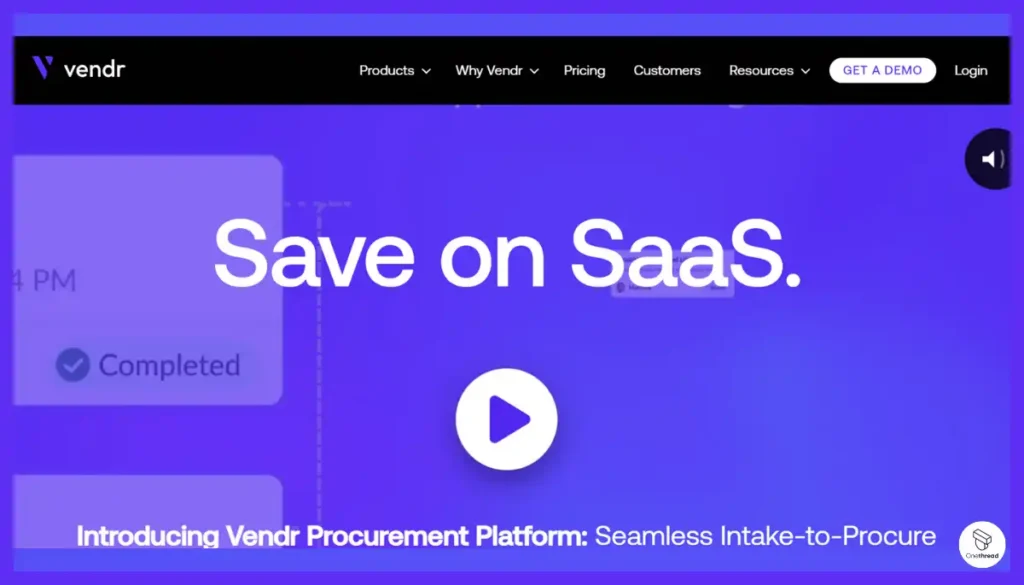
Organizations seeking superior spend management capabilities compared to Apptio should consider Blissfully, now part of Vendr following its February 2022 acquisition. Blissfully, as part of the Vendr product suite, provides a compelling alternative focused on efficient procurement and technology purchase workflows.
With intuitive employee intake forms and approval workflows, Blissfully eliminates the need for Apptio’s tedious manual processes for purchasing and approvals. It also centralizes supplier information and renewals to maximize visibility, alleviating data gaps common with Apptio.
Furthermore, Blissfully accelerates time-to-value, unlike Apptio’s steep learning curve. It quickly connects disparate source systems through smooth technical integrations. This allows organizations to rapidly drive procurement compliance, efficiency in approvals, savings on renewals, and consolidated supplier management.
For enterprises struggling with fragmented purchasing workflows and renewal processes – exacerbated by Apptio’s complexity – Blissfully presents an intuitive solution now backed by Vendr’s purchase intelligence capabilities. It focuses squarely on smoothing enterprise software purchasing and subscriptions, unlike Apptio’s broad IT financial scope.
Key Features of Blissfully (Currently Vendr)
These differentiation capabilities of Blissfully (Vendr) position it as a leading Apptio alternative:
Intakes:
Provides a centralized employee portal for teams to easily submit new software and services requests, enabling finance oversight of purchasing journeys while collecting all relevant details.
Approval Workflows:
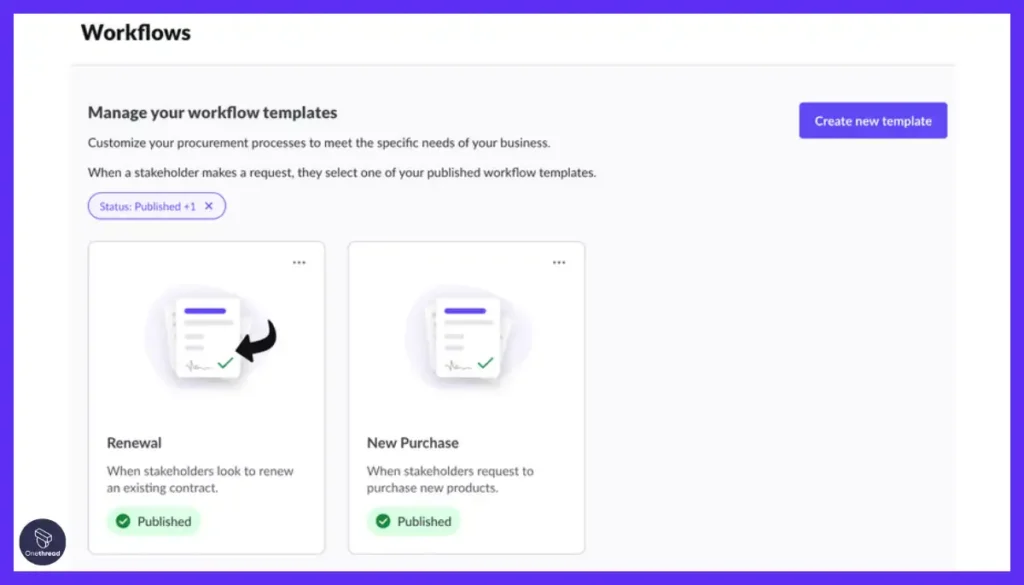
Configures conditional, automated approval workflows between finance and requesters by integrating ticketing systems to accelerate chain-of-command sign-offs for new purchases.
Renewal Management:
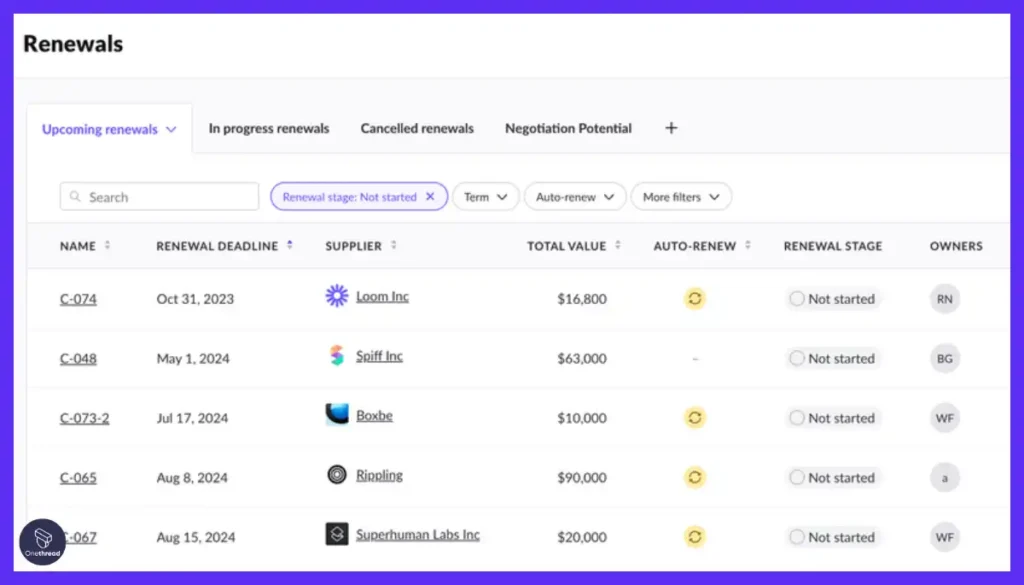
Gets complete visibility into all upcoming contract renewals in one dashboard to maximize savings by leveraging discount opportunities and Microsoft Excel-like pivot tables.
Supplier Management:
Consolidates supplier records, documents, communications, and agreements in a single hub to standardize and simplify vendor relationship management.
Spend Analytics:
Offers real-time visualizations of historical spending mapped across vendors, business units, and locations with trends and forecasts to inform data-backed purchase decisions.
Seamless Integrations:
Connects with financial systems, marketplaces, ticketing tools, and contract repositories through APIs and native connectors for end-to-end purchasing visibility.
Pros of Blissfully ((Currently Vendr)
- Smoothens and automates procurement workflows
- Expedites spending approvals 3x faster
- Maximizes savings on SaaS renewals
- Centralized supplier relationship management
- Guarantees satisfaction
- Connects many key business systems
Cons of Blissfully (Currently Vendr)
- Still a relatively new product
- Limited advanced analytics capabilities
- Lacks insights into infrastructure costs
Blissfully (Vendr) Pricing Plans
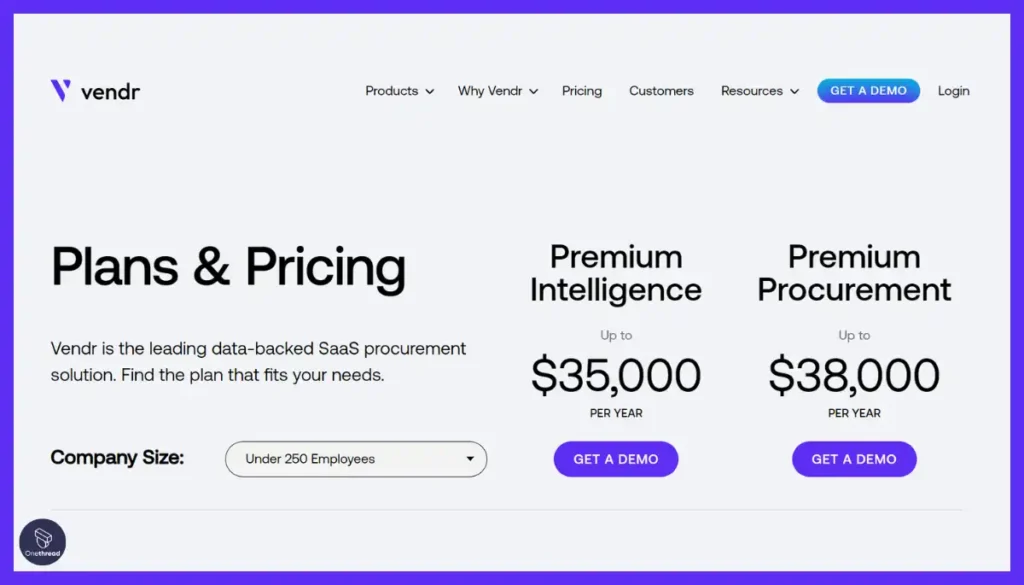
- Premium Intelligence: Up to $35,000 per year
- Buyer guides and negotiation help
- Contract analysis
- Basic integrations
- Premium Procurement: Up to $38,000 per year
- Intakes, approvals, renewal management
- Supplier management
- More integrations
What Users Say About Vendr?
Review on G2: 4.6 out of 5
“What do you like best about Vendr?
Keeping track of vendors and when they renew was becoming hard to manage. Vendr gives us a platform to track and store all this information, The Vendr rep helps us get through the procurement process and requests all due diligence and other documentation for security and legal reviews. They then store the contracts and track when the vendor will renew. They also helped us define what we want from vendors and refine the internal workflow used to help track the process.
What do you dislike about Vendr?
Although Vendr overall does a nice job helping us negotiate, tracking documentation, and recommending procurement standards, I still need to track what is going on and clearly state what I want with each contract. This may also include getting involved with the negotiation to help push the vendor pricing down a little more. Vendr helped us develop a procurement process and gave us a tool to manage it but this development was tedious.”- Cathy H.
Is Blissfully (Currently Vendr) Better Than Apptio?
Choose Blissfully by Vendr over Apptio for smoother procurement workflows, approvals, renewals, and licensing related to SaaS and enterprise technology. With its intuitive employee portal and integration capabilities, Blissfully conquers Apptio’s notoriously tedious purchasing and subscription management processes.
Yet Apptio remains the leader in holistic IT financial governance, providing unparalleled visibility and advanced analytics across environments. It outperforms Blissfully’s more limited reporting.
4. Nicus ITFM Suite
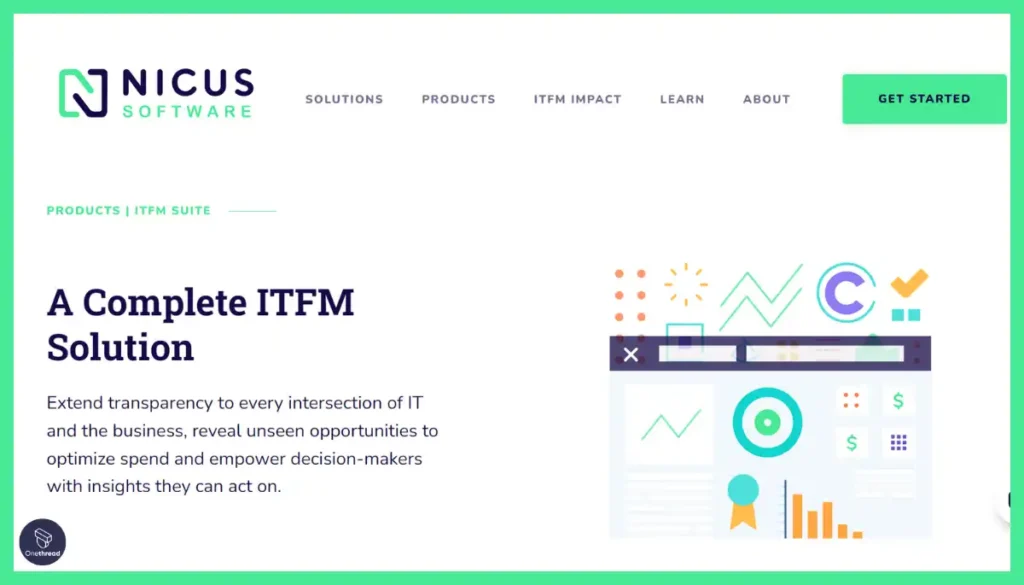
Organizations looking to simplify IT financial transparency should consider Nicus ITFM Suite as a more user-friendly alternative to Apptio’s complex capabilities. Nicus ITFM fosters stronger collaboration between IT and business teams through customizable data tailored for diverse stakeholders.
Unlike Apptio’s inconsistent reporting experiences, Nicus ITFM provides a unified “source of truth” to enable accurate benchmarking, forecasting, and tracking of all technology costs. It also equips decision-makers at all levels with the trusted insights they need – overcoming limitations in Apptio’s unintuitive data and analytics.
Furthermore, Nicus ITFM delivers strong yet flexible IT finance controls through budgets and portals. This shifts the culture from mandated governance in solutions like Apptio towards empowered self-service and accountability across the organization.
With a partnership-focused approach optimized to each stakeholder’s perspective, Nicus ITFM breaks down barriers presented by Apptio’s steep learning curves. It makes IT financially transparent through tailored, interactive data that fosters collaboration on costs and strategy.
Key Features of Nicus ITFM Suite
Nicus ITFM Suite delivers partnerships-driven IT financial management features distinct from Apptio:
Centralized Finance Hub:
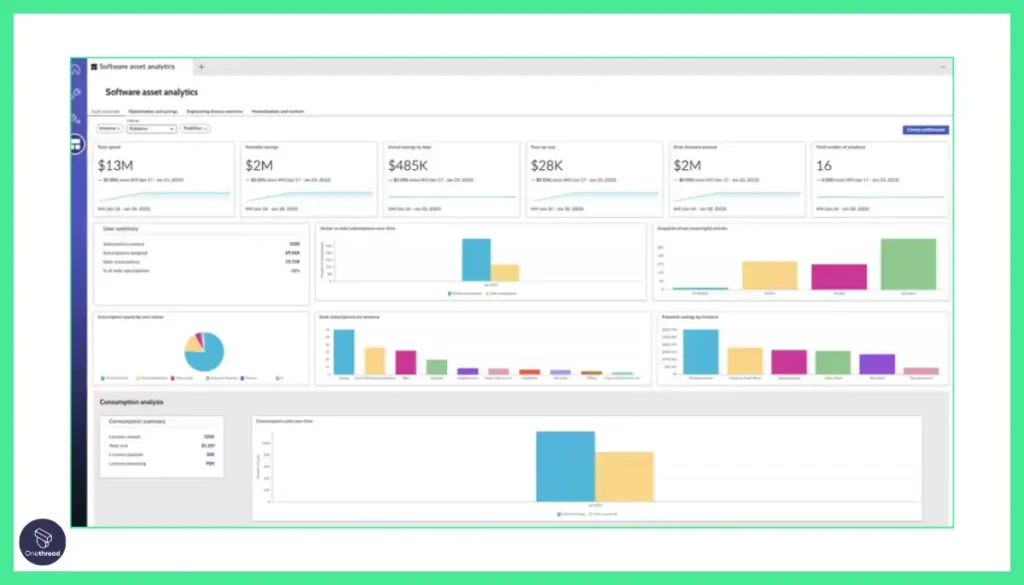
Consolidates all financial planning, tracking, and analytics for IT and business systems into a unified platform with a single source of truth.
Role-Based Portals:
Offers tailored self-service interfaces for finance, IT, procurement, and business teams to access relevant insights and collaborate.
Granular Cost Tracking:
Provides comprehensive visibility into all technology costs segmented by accounts, locations, applications, projects, assets, and more.
Benchmarking and Forecasting:
Leverages historical data and peer benchmarks to model budget scenarios and produce accurate forecasts aligned with business plans.
Spend Optimization:
Identifies wasteful expenditures and recommends precise rightsizing and consolidation initiatives through detailed analytics.
Business Alignment:
Translates technical spending into relevant business metrics and outcomes to showcase IT value and shift technology conversations.
Pros of Nicus ITFM Suite
- Extends financial transparency across IT
- Identifies wasteful spending and inefficiencies
- Enables accurate tracking and forecasting
- Empowers stakeholders with insights
- Fosters collaboration between IT and business
- Tailors data and insights to stakeholders
Cons of Nicus ITFM Suite
- Mostly focused on IT finance
- Does not offer cloud management capabilities
- Limited ability to optimize infrastructure
Nicus ITFM Suite Pricing Plans
- Pricing information not provided by the vendor
What Users Say About Nicus?
Review on G2: 4.9 out of 5
“What do you like best about Nicus?
The tool is very straightforward to administer. I have 13 regular users in our IT Finance team plus a variety of users in other areas of IT and the Business. The normal administrative functions are easy to use and allow me to see most of the views I need out of the box. Customizing reports and tables is a drag-and-drop interface.
What do you dislike about Nicus?
There are a few views I would like to have as an administrator that are not part of the regular report package. This makes it harder to see what reports are available to particular users.”- Robert B.
Is Nicus ITFM Suite Better Than Apptio?
Nicus ITFM Suite edges out Apptio for organizations seeking collaborative, customizable IT financial management versus rigid TBM structures. With interactive data tailored to diverse stakeholders, Nicus fosters financial transparency rather than mandated governance under Apptio.
But Apptio is still the leading choice for global enterprises needing enterprise-grade ITBM capabilities at scale. Its IT reporting depth and breadth excel over Nicus ITFM’s serviceable but less advanced analytics.
5. Flexera
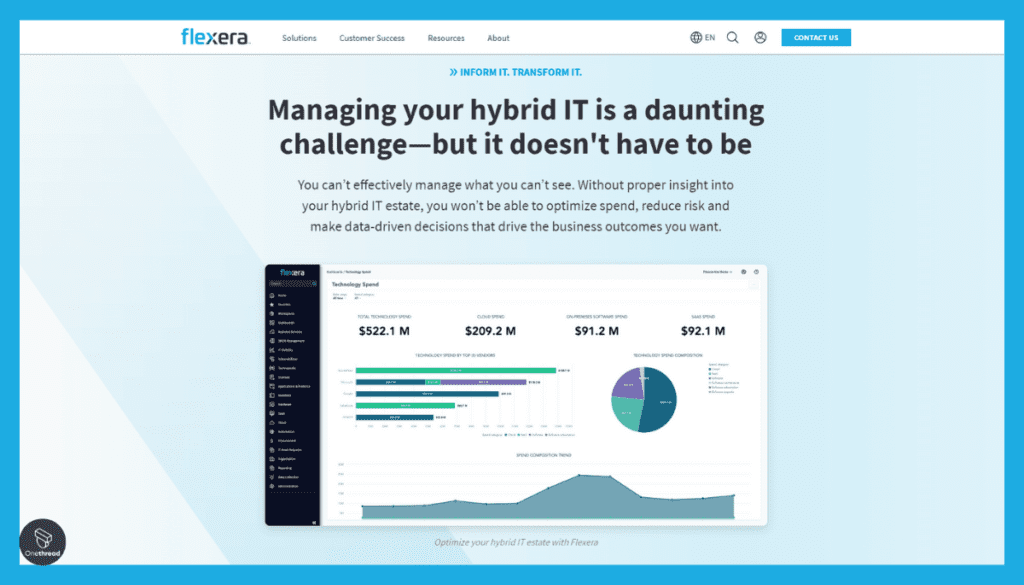
For holistic visibility and control beyond Apptio’s siloed IT financial management, Flexera’s Cloud Management Platform presents a comprehensive alternative. Spanning on-premises, SaaS, and multiple cloud environments, Flexera provides complete optimization, unlike Apptio’s narrow analytics.
Powered by Technopedia’s industry-leading data, Flexera delivers integrated capabilities from asset management to cloud cost governance. This unified view overcomes Apptio’s data gaps, while Flexera’s AI and automation eliminates tedious manual processes. Organizations also gain actionable insights to mitigate risks and maximize returns on technology investments.
Furthermore, Flexera facilitates smooth cloud transformations through detailed migration planning and cost assessments – overcoming Apptio’s constraints. With rapid time-to-value and a platform designed for change, Flexera allows IT and business leaders to confidently accelerate innovation. This contrasts limitations in Apptio’s ability to drive tangible business impact beyond just reporting.
For complete visibility and control to optimize complex, evolving technology environments, Flexera rises as a leader while Apptio users continue facing fragmented experiences. Flexera also forges a proactive partnership between IT and the business rather than mandated governance through Apptio’s rigid models.
Key Features of Flexera
Flexera conquers Apptio gaps through complete hybrid IT visibility and control features:
Hybrid IT Visibility:
Stitches together dependencies between business services and underlying infrastructure across on-prem, SaaS, and multi-cloud to enable data-driven decisions.
Automated IT Asset Management:
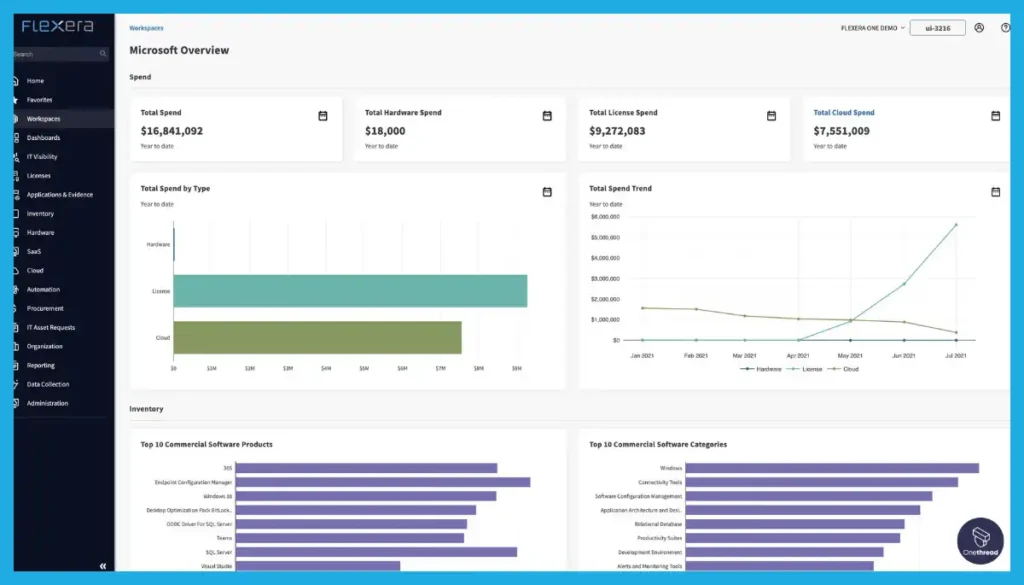
Optimizes software license and hardware costs leveraging analytics for accurate inventory, utilization metrics, and end-of-life tracking across environments.
AI-Powered Cloud Migration:
Assesses migration readiness, simulates workload placement, and sizes target platform through ML-enabled analysis for accelerated transformation.
Holistic Cost Governance:
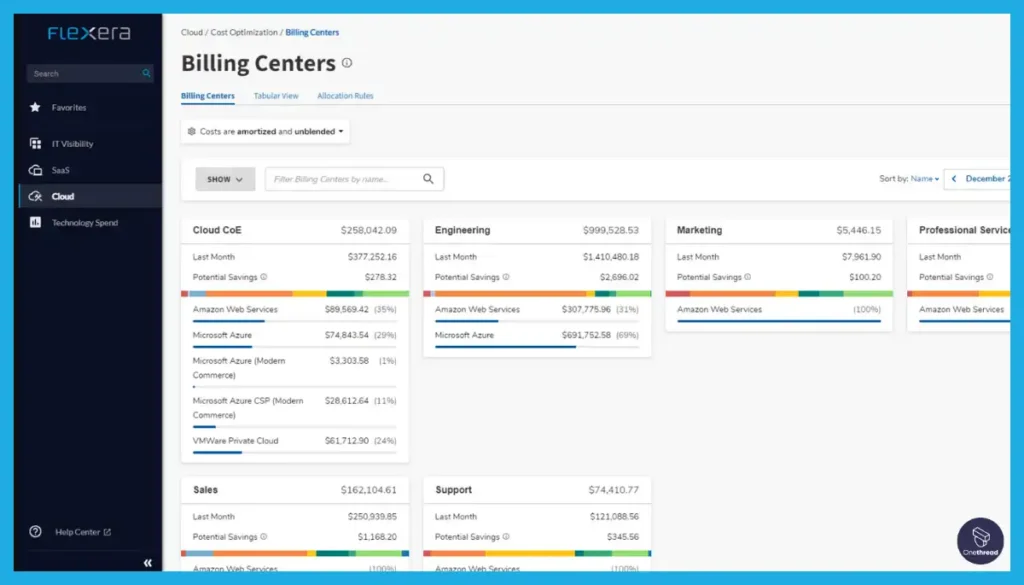
Correlates usage trends, budgets, tags, resources, and services to right-size investments and maintain guardrails through actionable intelligence.
Ecosystem Integrations:
Offers pre-built connectors to leading enterprise tools like ServiceNow along with APIs to seamlessly incorporate capabilities into existing flows.
Continuous Compliance:
Enables organizations to adhere to complex regulations like GDPR across their estate through automated policy enforcement, auditing, and reporting.
Pros of Flexera
- Provides visibility across entire hybrid IT estate
- Identifies wasteful spending and inefficiencies
- Enables better software asset management
- Leverages AI/ML for automation
- Mitigates risks and reduces costs
- Accelerates innovation and growth
Cons of Flexera
- Expensive for smaller businesses
- Complex workflows and procedures
- Steep learning curve
Flexera Pricing Plans
- Pricing information not provided by the vendor
What Users Say About Flexera?
Review on G2: 3.7 out of 5
“What do you like best about Flexera?
We first started using the RightScale platform at a time when AWS only had an API and didn’t have an administrative console. From the beginning, RightScale made it possible to minimize the number of server images we needed by making it easy to create server templates that would take a common base image and configure it after boot. It also makes it easy to remote command things to run on multiple servers at once.
What do you dislike about Flexera?
Now that every cloud platform has a robust console up, the original benefit of having a web-based console for managing servers instead of relying purely on an API has dwindled considerably. Most things I would have previously relied on CMP for can now be done with a few clicks in the individual cloud. As such the Cost to Value ratio on CMP has changed considerably since we joined. What was once a must-have feature is now a commodity.”- Nick M.
Is Flexera Better Than Apptio?
Select Flexera over Apptio for complete visibility and control spanning your hybrid IT estate and supply chain. With integrated asset management, usage analytics, and license optimization, Flexera conquers Apptio’s data silos and partial visibility leading to overspending.
But Apptio still edges out Flexera for advanced IT financial modeling tailored to complex enterprise needs. Large global organizations do benefit from Apptio’s proven large-scale ITBM capabilities.
6. Azure Cost Management
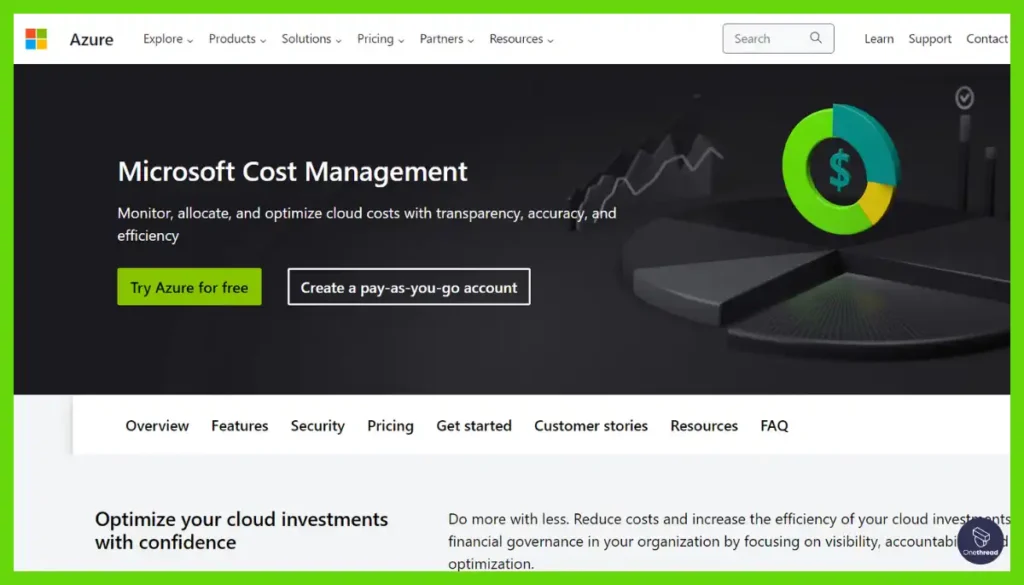
Organizations struggling with Apptio’s multi-cloud limitations should consider Azure Cost Management for simplified optimization across Azure and other clouds. With full native integration across Azure, it overcomes data and reporting inconsistencies common with Apptio implementations.
Specifically, Azure Cost Management enriches usage data with flexible custom tags, unlike Apptio’s rigid data structure. It also leverages Microsoft’s industry-leading AI for powerful predictions and automation – eliminating Apptio’s manual processes. Users gain actionable recommendations tailored to their environment versus one-size-fits-all guidance.
Additionally, Azure Cost Management provides unified visibility through intuitive dashboards surfaced within the Azure Portal itself. This simplifies insights for Azure-centric organizations rather than Apptio’s complex separate interface. Users can also customize reporting with Power BI and APIs for their unique requirements.
With continuous cost monitoring and forecasting, Azure Cost Management gives enterprises confident control over cloud budgets. All while driving efficiency through role-based accountability. For organizations committed to Azure and Microsoft cloud solutions, it presents an integrated alternative bypassing limitations faced in Apptio’s Microsoft integrations.
Key Features of Azure Cost Management
Azure Cost Management optimizes cloud costs with native integration features that Apptio lacks:
Multi-Cloud Cost Analytics:
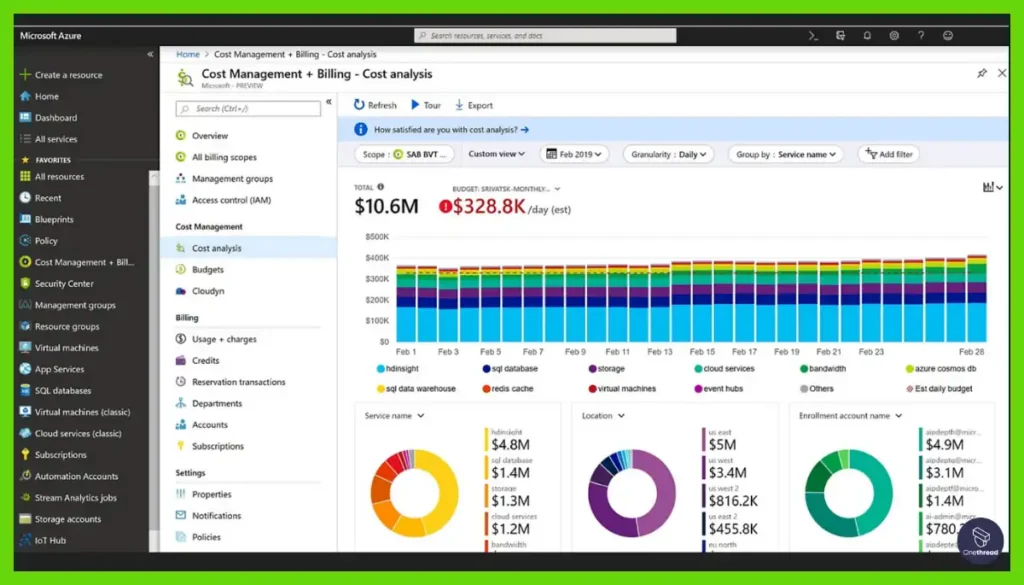
Ingests usage data spanning Azure and AWS to unify cost monitoring, allocation, and optimization across cloud platforms through interactive dashboards.
Granular Tagging and Alerting:
Applies customizable tags and budgets at resource, resource group, or subscription level for accurate accountability aligned to business needs.
AI-Powered Recommendations:
Leverages Microsoft’s advanced analytics capabilities to suggest optimized service limits, regimes, and purchasing plans tailored to workloads.
Seamless Azure Integration:
Offers tight integration with Azure portal, accounts, and reporting services like Power BI for simplified access and analysis right within familiar tools.
Enterprise-Grade Security:
Implements rigorous access controls, encryption, logging, auditing and compliance certification aligned to enterprise needs for trusted cost governance.
Open API Access:
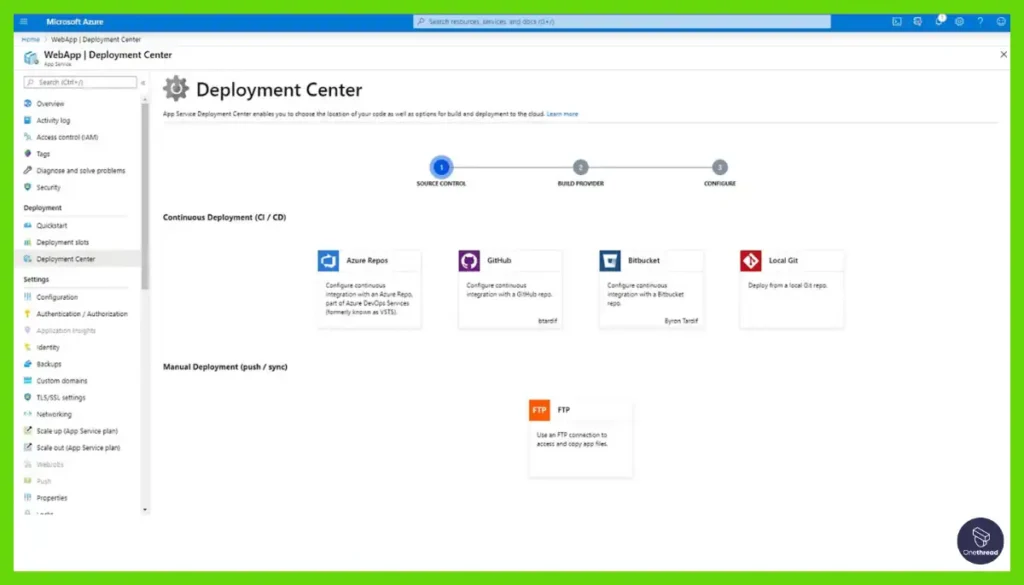
Provides API integration options to extract raw cost data, trigger actions, and incorporate intelligence into existing platforms to extend value.
Pros of Azure Cost Management
- Monitors, allocates and optimizes cloud costs
- Integrates natively with other Azure services
- Leverages Microsoft’s AI capabilities
- Provides budgeting capabilities
- Identifies optimization opportunities
- Customizable with APIs and Power BI
Cons of Azure Cost Management
- Limited to Microsoft Azure environment
- Lacks advanced analytics of third-party tools
- Less flexible than standalone cost solutions
Azure Cost Management Pricing Plans
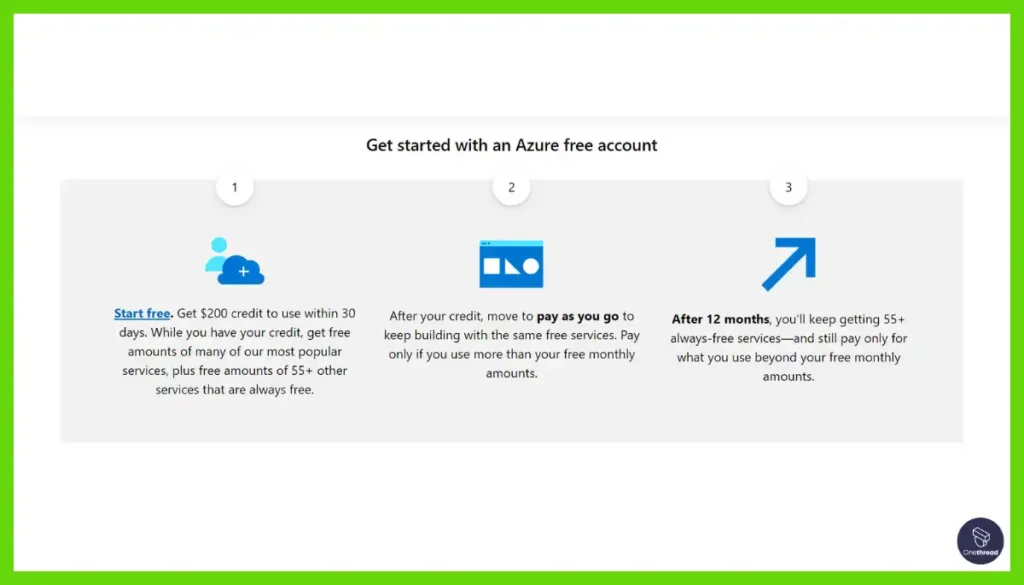
- Free: Free for Azure cost management
- Premium: Additional fees apply
- Connector for AWS: 1% of managed AWS spend per month
What Users Say About Azure Cost Management?
Review on G2: 3.9 out of 5
“What do you like best about Azure Cost Management?
2 great things that I like about Microsoft Azure is, one the great performance that this software has pouring resources into the cloud without delays, and also including in the yearly fee a big cloud storage. Secondly, this awesome software is available to run on Linux systems, which makes it great especially for software like Azure.
What do you dislike about Azure Cost Management?
The factor that makes me not give a 10/10 to this software is the cost. This software is too high in its price, and of course, I am talking about a company purchasing it, but still, at 14K a year, it brings second thoughts to someone wanting to try it out for the first time.”- Horacio C.
Is Azure Cost Management Better Than Apptio?
Azure Cost Management is the superior option over Apptio for organizations committed to Microsoft Cloud solutions. With native Azure integration enabling granular visibility and optimization, Azure Cost Management addresses limitations in Apptio’s Microsoft product support.
Yet Apptio remains the choice for multifaceted IT financial analytics beyond just Azure and Microsoft environments. It provides unmatched data normalization across more complex multi-cloud estates.
7. CloudCheckr, from Spot by NetApp
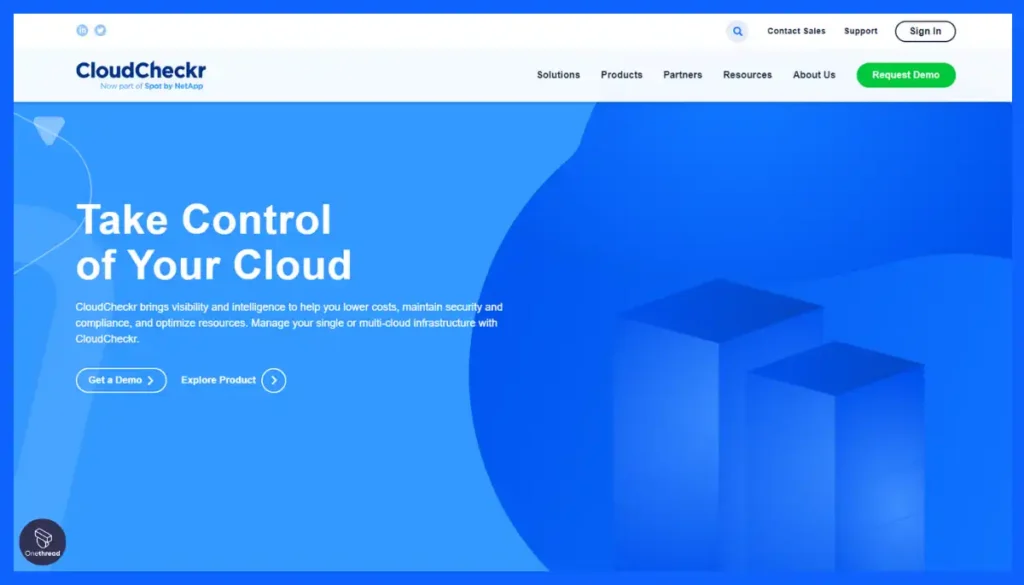
Organizations struggling with Apptio’s lack of actionable cloud optimization insights would benefit from exploring CloudCheckr, from Spot by NetApp. With hundreds of out-of-the-box best practice checks and analytics-focused recommendations, CloudCheckr helps enterprises eliminate waste and maximize cloud efficiency.
In particular, CloudCheckr provides continuous and granular visibility into resource utilization and spending trends, unlike Apptio’s limited snapshots. With customizable dashboards and role-based visibility, stakeholders get insights tailored to their needs, overcoming Apptio’s one-size-fits-all rigidity.
Furthermore, CloudCheckr enables policy-driven automation for governance based on utilization and consumption metrics – going beyond budget thresholds common in Apptio. Its extensive automation capabilities also help streamline manual processes exacerbated by Apptio’s complexity.
With CloudCheckr, enterprises can accurately allocate costs, strengthen security, and increase accountability across cloud environments. The solution supports the scale and customization needed by large regulated organizations struggling to optimize the cloud with Apptio alone.
Key Features of CloudCheckr
CloudCheckr provides analytics-based optimization features missing in Apptio:
Unified Cloud Visibility:
Ingests granular asset inventory, performance metrics, access logs, and cost data across AWS, Azure, GCP, and on-prem environments for a unified view of hybrid cloud.
Actionable Analytics:
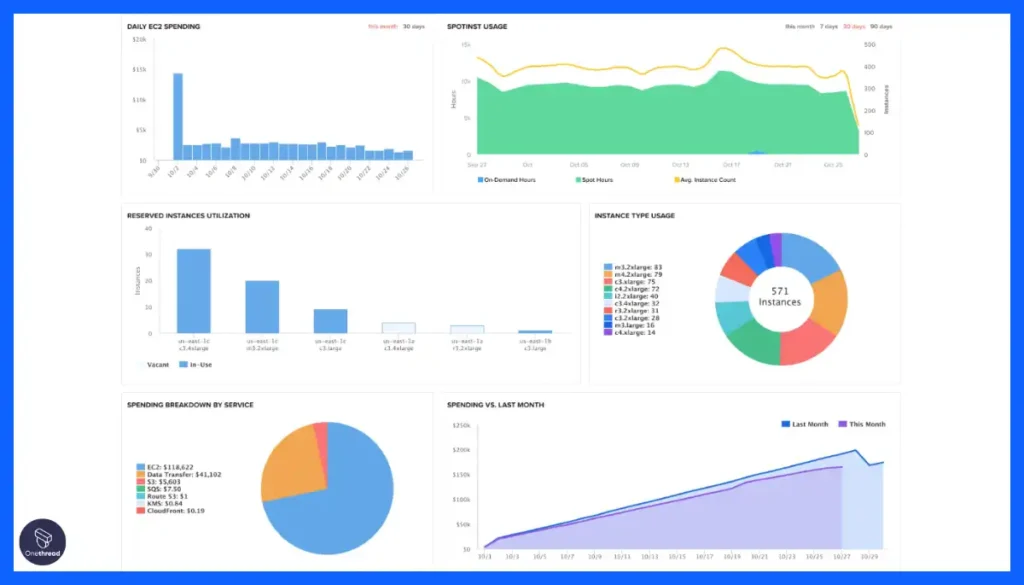
Leverages ML and analytics to provide targeted rightsizing initiatives, purchase recommendations, and reclamation alerts to control costs.
Automated Governance Checks:
Executes hundreds of built-in policy scans aligned to CIS benchmarks across security, compliance, configurations, access control, and resources.
Custom Workflow Automation:
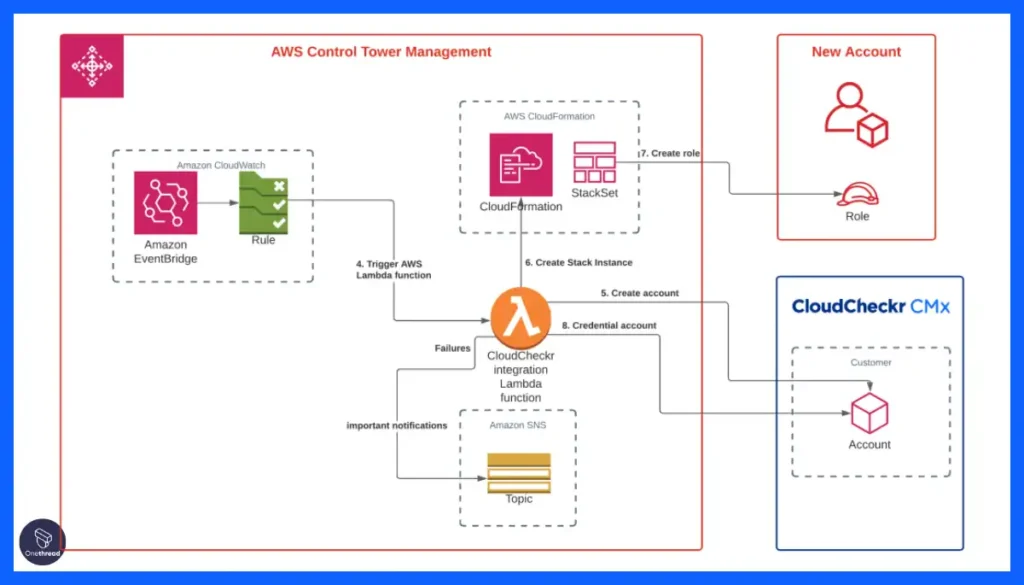
Enables creation of “checkbooks” to automate error remediation, tag enforcement, notifications, and other processes through a no-code rule builder.
Role-Based Access Control:
Provides administrators with fine-grained control over user permissions, data access, UI customizations, and API keys by profile.
Bring Your Own Data:
Ingest insights from existing CMDBs, monitoring tools, ITSM platforms, and other sources into the platform through API integrations for a complete picture.
Pros of CloudCheckr
- Visibility into cloud consumption and spending
- Identifies misconfigured resources
- Enables accurate cost allocation
- Hundreds of best practice checks
- Supports large enterprises and MSPs
- Unique analytics-driven approach
Cons of CloudCheckr
- Steep learning curve
- Heavy focus on governance and compliance
- Lacks native infrastructure optimization
CloudCheckr Pricing Plans
- Trial: Free Trial available
- Premium: Quotation-based pricing
- Percentage of cloud spend
- Minimum monthly fees apply
What Users Say About Cloud Analyzer?
Review on G2: 4.4 out of 5
“What do you like best about Cloud Analyzer?
The Cloud Analyzer platform offered by Spot is best for optimizing our cloud expenses and resource management. Within a few steps, we can overview our enterprise cloud spending and prepare a workaround to build a more cost-efficient architecture. It efficiently tracks and monitors our cloud expenses and targets wastage and potential areas where we can optimize our AWS platform further through its executable action items.
What do you dislike about Cloud Analyzer?
Overall, Spot Cloud Analyzer is great for our organization as it provides fantastic visibility to measure cost and improve efficiency in our AWS platform. An area of improvement could be suggested in its Documentation, where further use cases could be briefed.”- Rithika G.
Is CloudCheckr (Formerly Cloud Analyzer) Better Than Apptio?
Select Spot CloudCheckr over Apptio for actionable cloud optimization leveraging hundreds of out-of-the-box best practice checks. With precise analytics-based visibility into utilization trends, Spot CloudCheckr conquers Apptio’s static cloud reporting.
But Apptio is still a leading option for global enterprises requiring proven scale and maturity for IT financial governance across public and private clouds. Spot CloudCheckr capabilities still emerging.
8. VMware Tanzu CloudHealth
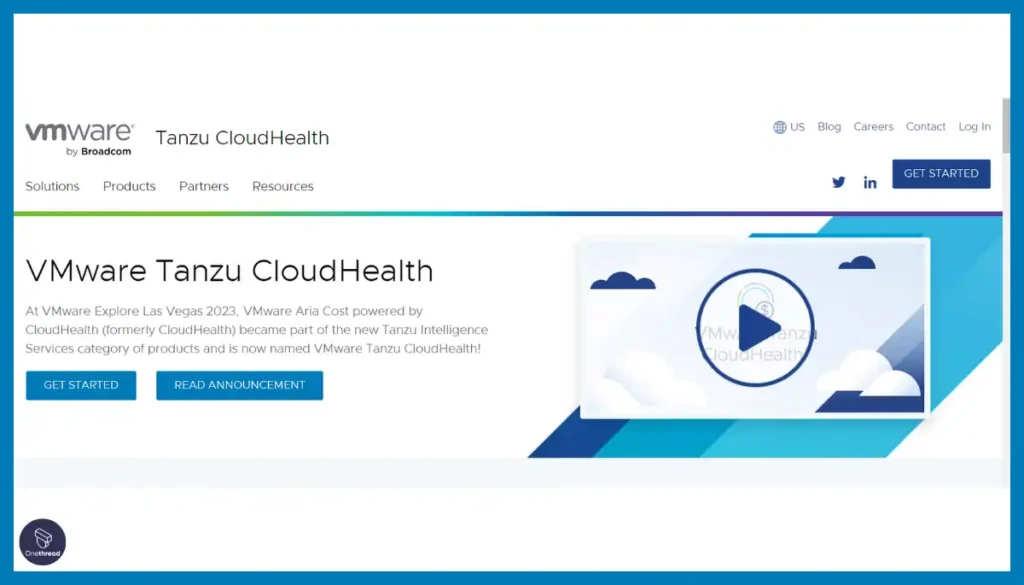
Organizations struggling with Apptio’s limited cloud support should consider VMware Tanzu CloudHealth for multi-cloud visibility and optimization. With native integrations across leading public clouds, Tanzu CloudHealth provides the flexibility lacking in Apptio’s focus on Azure and AWS.
In particular, Tanzu CloudHealth enables enterprises to implement consistent governance and security policies across their multi-cloud environments. This capability overcomes management gaps created by Apptio’s manual, siloed cloud implementations. Tanzu CloudHealth also provides right-sizing recommendations tailored to actual usage trends versus Apptio’s static budgets.
Furthermore, Tanzu CloudHealth helps unify cloud operations workflows through customized automation. This eliminates tedious manual processes required in Apptio such as data imports/exports, while enforcing standards at scale. Supported by VMware and over 20,000 global customers, Tanzu CloudHealth delivers on multi-cloud challenges that Apptio users continually grapple with.
For enterprises struggling to optimize costs, security, and governance across leading public clouds with Apptio, Tanzu CloudHealth warrants strong consideration as an integrated alternative. Its cloud-native focus squares on the multi-cloud challenge with specific optimization tooling.
Key Features of VMware Tanzu CloudHealth
VMware Tanzu CloudHealth features specialized support for multi-cloud management not matched by Apptio:
Unified Cloud Cost Management:
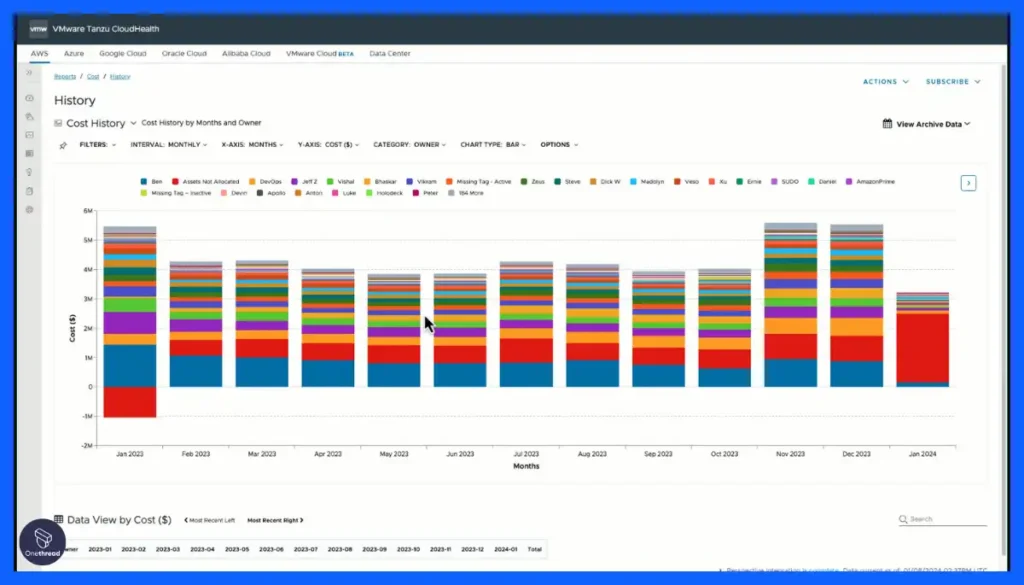
Centralizes cloud cost monitoring, allocation, optimization, and planning across public clouds, private data centers, and hybrid environments from one platform.
Continuous Compliance Monitoring:
Executes hundreds of policy scans out-of-the-box and via custom workflows to harden security, access, configurations, and regulatory overages across the cloud.
Actionable Recommendations:
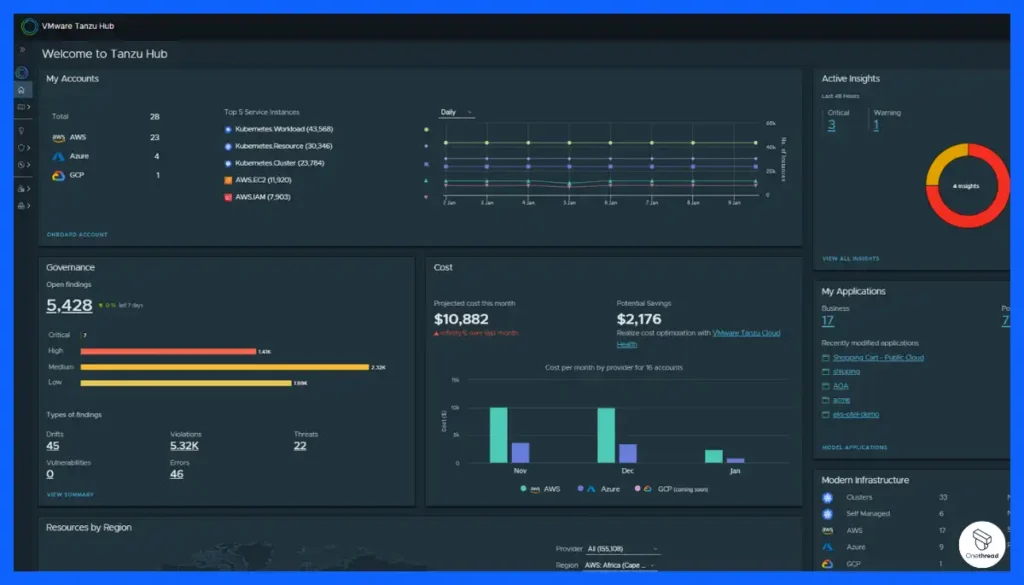
Leverages CloudHealth’s machine learning expertise to provide targeted rightsizing initiatives, purchasing recommendations, and reclamation alerts to control costs.
Pre-Built Integrations:
Offers native connectors with ServiceNow, Datadog, and other systems to ingest supplementary data for context-aware analysis and end-to-end workflows.
Flexible Budgeting and Chargeback:
Enables administrators to set custom budgets, alerts, tags, reports, and chargeback rules tailored to specific teams, applications, accounts, or labels.
Trusted Global Expertise:
Backed by VMware with over 20 years of experience managing enterprise infrastructure and applications to ensure best practices for multi-cloud governance.
Pros of VMware Tanzu CloudHealth
- Simplifies cloud financial management
- Identifies optimization opportunities
- Strengthens cloud governance
- Over 20,000 global customers
- Recognized as an industry leader
- Specialized expertise in cloud
Cons of VMware Tanzu CloudHealth
- Expensive for smaller organizations
- Complex workflows and configuration
- Mostly focused on cost optimization
VMware Tanzu CloudHealth Pricing Plans
Basic: Up to $150K AWS spend per month, $45,000 per year
Professional: Up to $300K AWS spend per month, $90,000 per year
Enterprise: Up to $500K AWS spend per month, $150,000 per year
What Users Say About VMware Tanzu CloudHealth?
Review on G2: 4.1 out of 5
“What do you like best about VMware Tanzu CloudHealth?
VMware Aria Cost powered by CloudHealth helps us understand the cloud costs of our customers with a deep drill down to each service, linked account, etc. It also helps us visualize the data using dashboards and view some cost savings recommendations.
What do you dislike about VMware Tanzu CloudHealth?
In my opinion, VMware Aria Cost powered by CloudHealth is lacking a central view of cost savings recommendations for many services. Although there are recommendations for commitments and a few others, there is no central location to view all recommendations (for example: EIPs that are not assigned to any instance) and this makes it a bit harder to understand how to save on costs.”- Daniel V.
Is VMware Tanzu CloudHealth Better Than Apptio?
VMware Tanzu CloudHealth triumphs over Apptio for organizations struggling with multi-cloud visibility and consolidation using Apptio alone. With specialized support for leading public clouds, Tanzu CloudHealth addresses Apptio’s AWS and Azure limitations head-on.
Yet Apptio remains the primary choice for holistic IT financial governance across complex hybrid infrastructure landscapes. It is positioned as an enterprise ITBM benchmark that VMware Tanzu CloudHealth cannot replace wholesale.
9. Bee360
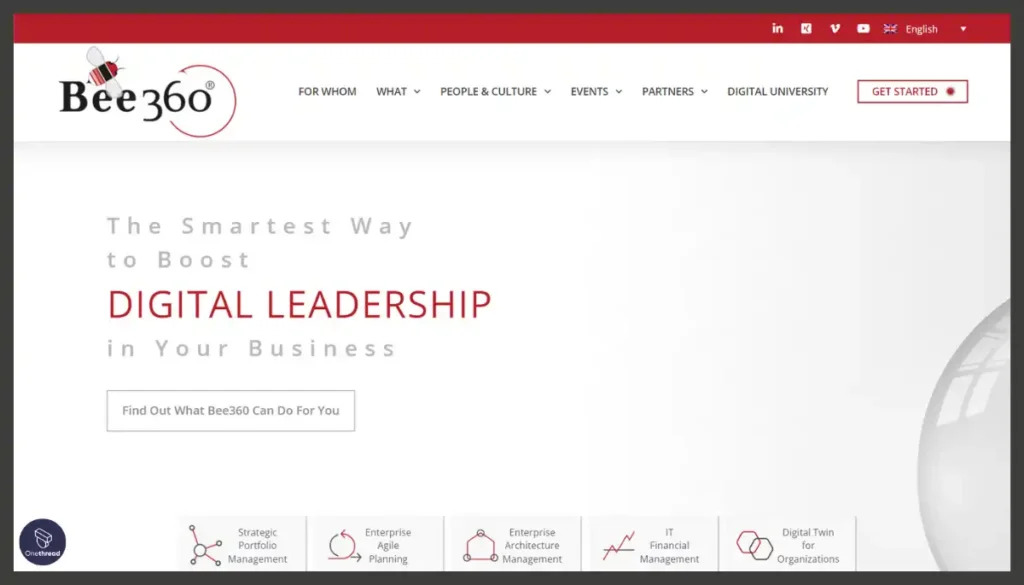
For organizations seeking a more well-rounded yet affordable alternative to Apptio’s complex capabilities, Bee360 is emerging as an attractive option. With its user-friendly interface and focus on intuitive data visualization, Bee360 overcomes core challenges faced by many Apptio users.
Specifically, Bee360 provides real-time analytics spanning budgets, forecasts, and cloud costs through customizable dashboards. This enables data-driven decision-making across IT spending, contrasting limitations in Apptio’s static reporting. Bee360 also offers configurable workflows to eliminate tedious approval and planning processes inherent in Apptio.
Furthermore, Bee360 delivers strong cost management, integrated resource planning, and portfolio optimization features targeted for flexibility. Its scalable pricing and integration options cater to organizations without overburdening budgets and existing systems like some Apptio packages.
While Apptio has more advanced IT financial analytics, Bee360 strikes an optimal balance of comprehensive capabilities with adaptability. For enterprises seeking an integrated platform to streamline IT spend management at scale without high complexity, Bee360 emerges as an attractive option relative to Apptio.
Key Features of Bee360
These automation and analytics capabilities make Bee360 an attractive Apptio alternative:
Real-time Analytics
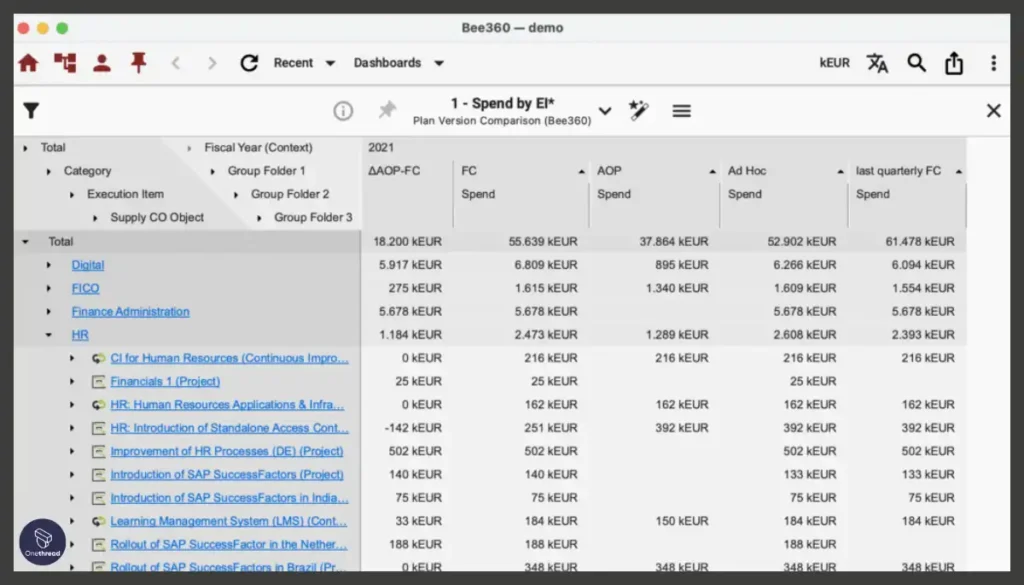
Bee360 comes with real-time analytics features. These give you a 360-degree view of your IT spending. You can track budgets and forecasts with high accuracy. It helps you make better decisions, faster.
Cloud Cost Management
Managing cloud expenses can be a headache. Bee360 makes it simple. It breaks down your cloud spending into easy-to-read reports. Now, controlling costs is just a click away.
Automated Workflows
Automation is the future. Bee360 understands this. That’s why it offers automated workflows. They help streamline your tasks, from budget approval to project planning. This boosts your team’s efficiency.
Comprehensive Dashboards
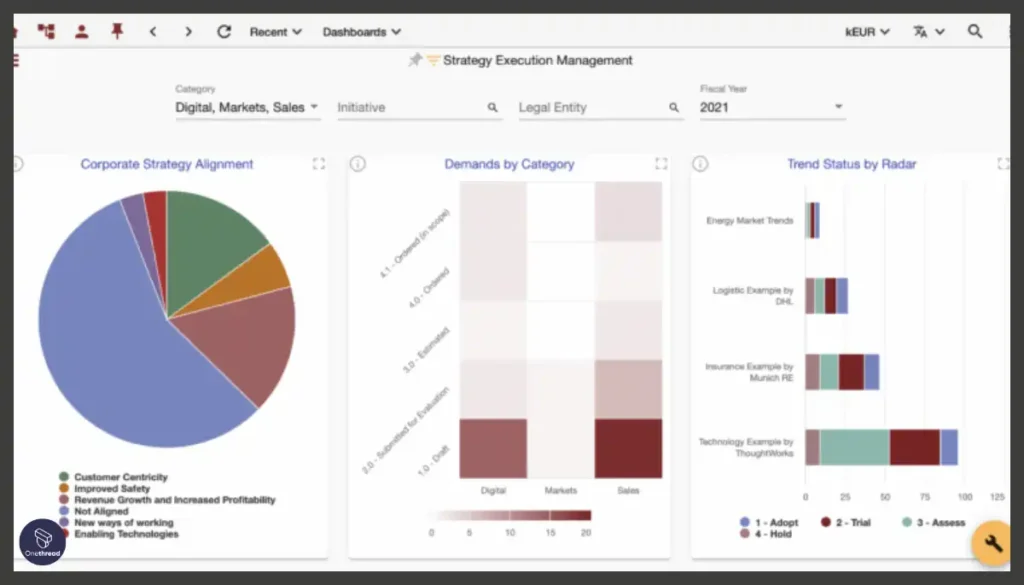
The dashboards in Bee360 are rich in features yet easy to use. They provide a snapshot of your IT spending. This means no more sifting through tons of data. Everything you need is right in front of you.
Customizable Reporting
One size doesn’t fit all. Bee360 offers customizable reporting options. Tailor your reports to fit your company’s unique needs. The process is intuitive and quick.
Pros of Bee360
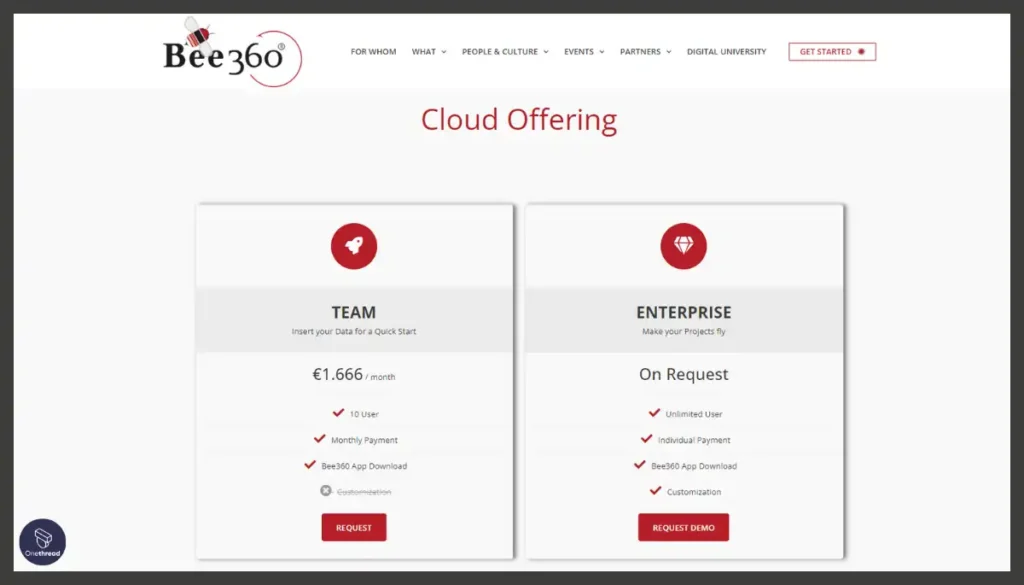
- User-friendly interface
- Robust analytics capabilities
- Flexible pricing plans
- Excellent customer support
- Efficient cloud cost management
Cons of Bee360
- Learning curve for some advanced features
- Limited third-party integrations
Pricing Plans
- Basic Plan: $30 per user/month
- Limited analytics
- No automated workflows
- Pro Plan: $60 per user/month
- Full analytics
- Automated workflows
- Enterprise Plan: Custom pricing
- Advanced features
- Priority support
What Users Say About Bee360?
- Review on Gartner: 4.1 out of 5
Is Bee360 Better Than Apptio?
Select Bee360 over Apptio for streamlined yet comprehensive IT financial management catered to mid-market needs. With robust analytics, customizable reporting, and automated workflows, Bee360 conquers data access and productivity challenges prevalent among Apptio users.
However, large enterprises may still prefer Apptio for proven scalability supporting complex global IT environments. Apptio also provides unmatched advanced predictive modeling capabilities.
10. CloudZero
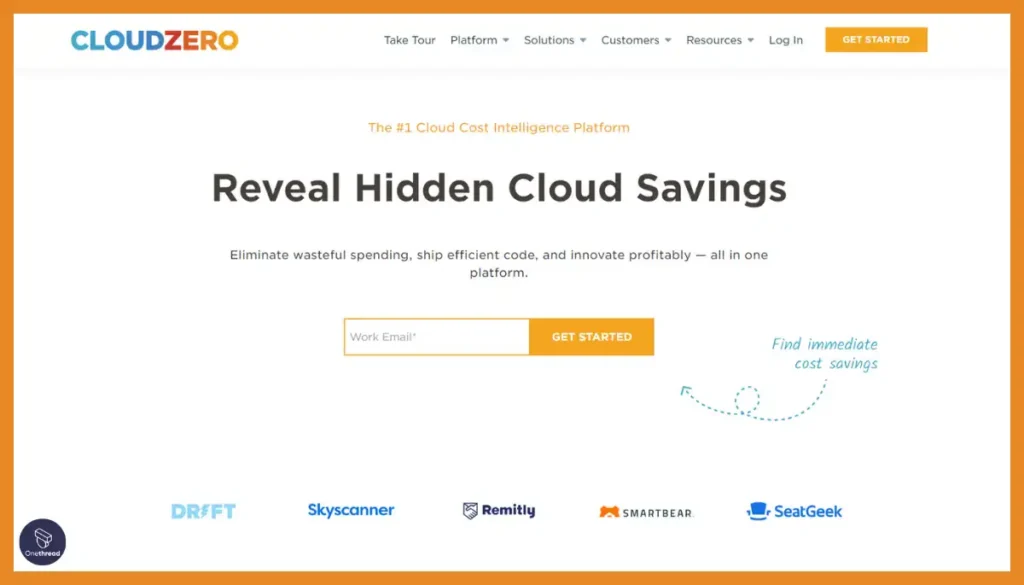
CloudZero offers another compelling alternative for organizations finding Apptio’s interface challenging to navigate. With its highly intuitive dashboards tailored to engineering teams, CloudZero alleviates much of the complexity organizations face in leveraging Apptio’s data.
By correlating cloud costs directly to features, products, and customers, CloudZero also provides clearer visibility than Apptio into how engineering decisions impact spending. Its real-time anomaly detection further enables organizations to stay on top of unexpected costs – an area where Apptio’s latency issues can expose companies to risk.
While Apptio attempts to serve a wide range of IT management needs, CloudZero’s specificity in cloud cost intelligence makes it ideal for engineering-driven teams seeking precise, actionable data to optimize cloud utilization and spending.
With robust customer reviews highlighting its usability and real-time cost insights, CloudZero stands out for its ability to demystify cloud finances for technical users – filling an important gap commonly seen with solutions like Apptio.
Features
CloudZero features real-time cost intelligence tailored for technical users’ needs unmet by Apptio:
Real-Time Cloud Cost Intelligence
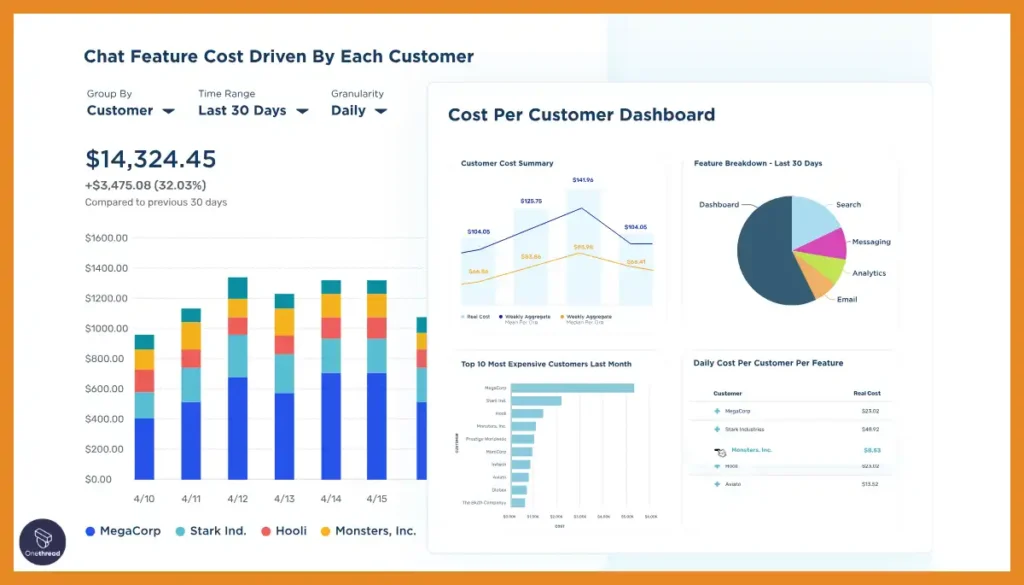
CloudZero provides live insights into cloud spending, enabling organizations to monitor and control costs with precision.
Engineering-Centric Approach
Designed with engineering teams in mind, CloudZero’s tools help engineers understand the cost impact of their decisions.
Anomaly Detection
It detects unusual spending patterns, helping organizations identify and address unexpected costs.
Integration with Cloud Providers
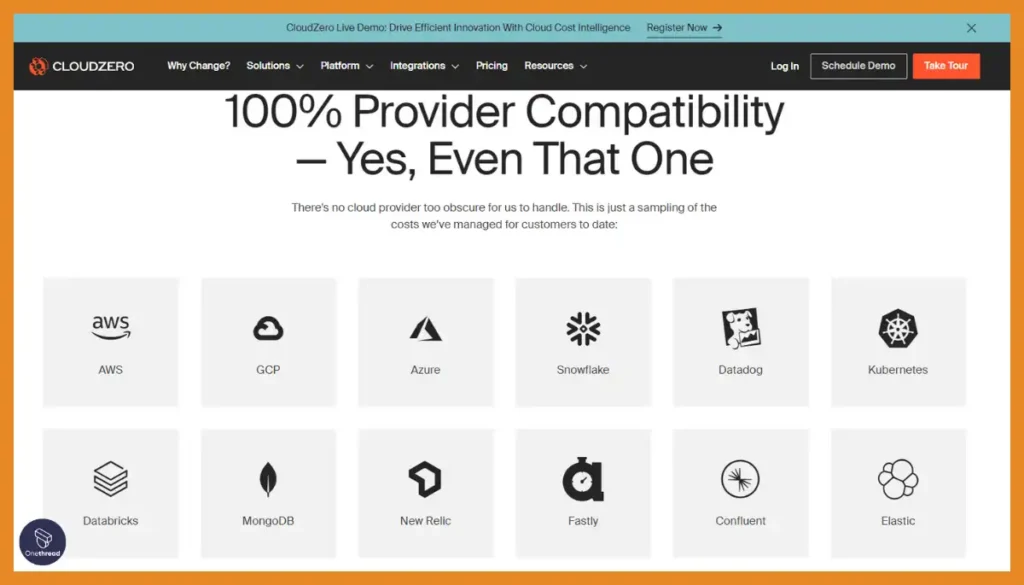
CloudZero supports integration with major cloud providers, offering a unified view across different platforms.
Customizable Dashboards
It allows users to create custom dashboards that reflect their specific needs and preferences, enhancing the user experience.
Pros of CloudZero
- Real-time insights into cloud spending.
- Focuses on the needs of engineering teams.
- Efficient anomaly detection for cost control.
- Seamless integration with various cloud providers.
Cons of CloudZero
- May not cover broader aspects of Technology Business Management (TBM).
- May require adaptation for non-engineering users.
- Limited functionalities beyond cloud cost management.
Pricing Plans
- Basic Plan: Offers essential cloud cost monitoring features.
- Advanced Plan: Includes anomaly detection and deeper insights.
- Enterprise Plan: Customized solutions with advanced support and features.
What Users Say About CloudZero?
Review on G2: 4.5 out of 5
“What do you like best about CloudZero?
They show you all the details of your spending. I especially appreciate their anomaly detection and alerts. That allows reacting quickly when something goes awry .,
What do you dislike about CloudZero?
I would like to see more flexibility with alert configuring. Allow more than one channel and e-mail, allow configure custom alert criteria.
We are also looking forward to being able to use CZ on the GCP.”- Igor P.
Is CloudZero Better Than Apptio?
CloudZero emerges as a better alternative to Apptio for engineering teams struggling to extract accessible cloud cost insights from Apptio’s technical data structure. With anomaly detection and customizable dashboards, CloudZero delivers clarity into the cost drivers that Apptio lacks.
But Apptio remains the choice for centralized ITBM governance across the broader enterprise. It surrounds CloudZero’s specialized engineering focus with holistic workflows and advanced analytics for CIOs.
11. CIO Cockpit Business
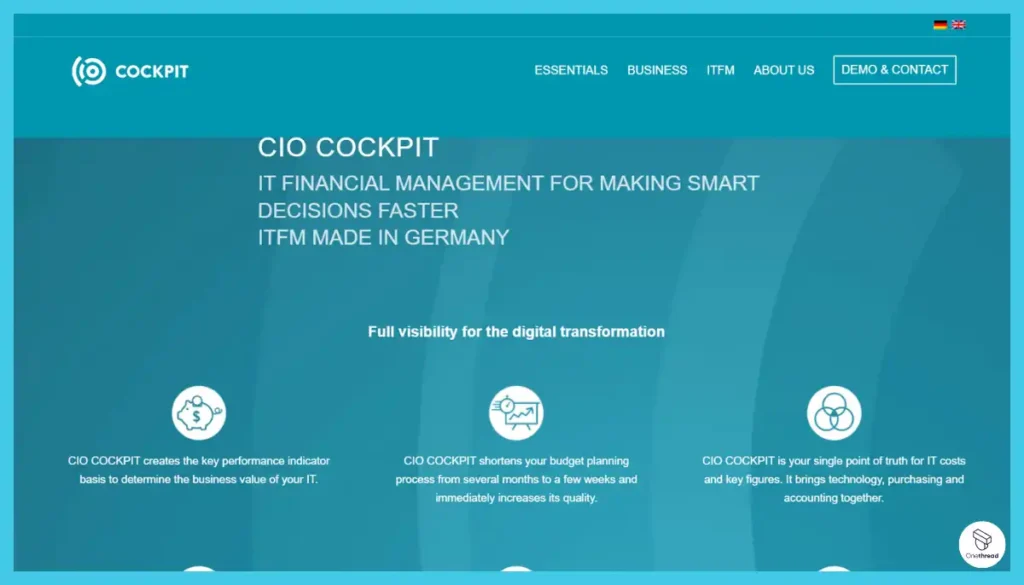
CIO Cockpit Business is another compelling all-in-one alternative for organizations finding Apptio lacking in breadth or depth of IT financial management capabilities. With its unified data integration from diverse sources, CIO Cockpit Business alleviates the integration and data accuracy issues commonly faced with Apptio implementations.
Real-time cost tracking also enables more responsiveness than what Apptio customers report experiencing when surprise costs or overages occur. Additionally, Apptio is often cited as having an unintuitive interface – an area where CIO Cockpit Business shines with its customizable, dynamic dashboards tuned precisely to IT leaders’ monitoring and reporting needs.
While Apptio offers functionality across IT spend management, CIO Cockpit Business outperforms specifically in providing financial oversight of critical SaaS and vendor relationships.
With advanced analytics features like predictive modeling not found in Apptio, CIO Cockpit Business empowers IT executives to forecast and optimize spending through data-driven insights not previously accessible. For IT leaders finding Apptio’s breadth not backed up by depth in key management capabilities, CIO Cockpit Business warrants strong consideration.
Key Features of CIO Cockpit Business
CIO Cockpit Business provides integrated data and enhanced analytics features conquering Apptio’s limitations:
Seamless Data Integration
The success of IT financial management lies in data accuracy. CIO Cockpit Business provides seamless data integration from multiple sources. It consolidates all your financial data in one place, whether it’s coming from accounting software or project management tools. This centralization saves you time and ensures data accuracy.
Real-Time Cost Tracking
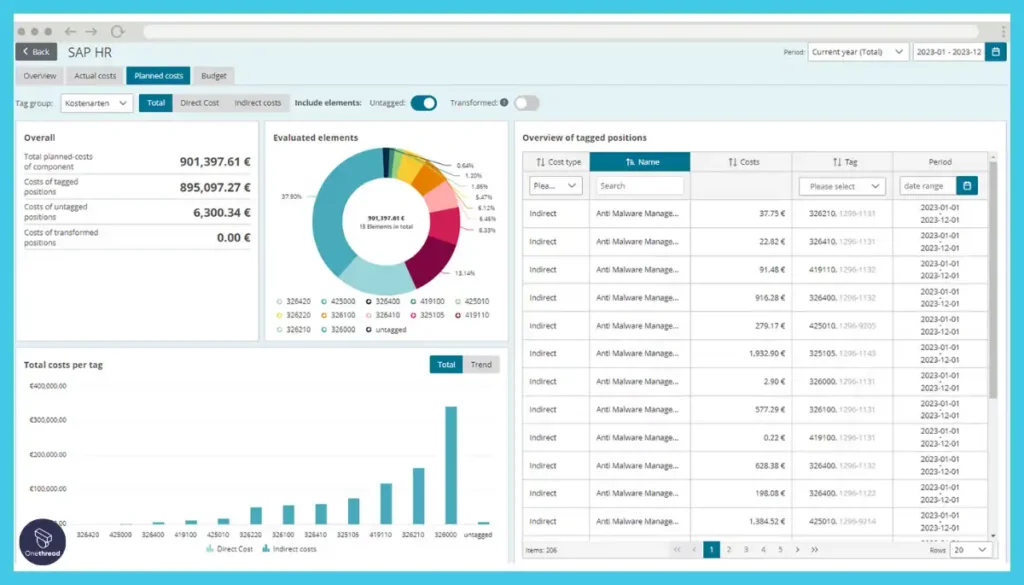
CIO Cockpit Business offers real-time cost tracking, a game-changer for any organization. This feature allows you to monitor costs as they occur. You can quickly identify cost overruns or inefficiencies and take immediate corrective action, thus avoiding unpleasant surprises at the end of the quarter.
Dynamic Dashboards
A well-designed dashboard can make a world of difference. CIO Cockpit Business offers dynamic dashboards that give you a 360-degree view of your IT spending. These dashboards are customizable and offer real-time updates, making data interpretation a breeze.
Predictive Analytics
Predicting future costs is a valuable feature. CIO Cockpit Business employs advanced predictive analytics algorithms. It takes into account historical data and current trends to provide future cost estimates. This helps you prepare for what’s next, whether it’s a market change or an internal project adjustment.
Vendor Management
Managing multiple vendors can be challenging. CIO Cockpit Business simplifies this with its built-in vendor management system. You can track contracts, assess vendor performance, and even manage renewals all within the platform. This centralizes your vendor interactions and makes management far less stressful.
Pros of CIO Cockpit Business
- Unified data integration
- Real-time cost monitoring
- Customizable dynamic dashboards
- Accurate predictive analytics
- Efficient vendor management
Cons of CIO Cockpit Business
- Steep learning curve
- Limited mobile accessibility
Pricing Plans
- Basic: $100 per user/month
- Basic data integration
- Standard dashboards
- Advanced: $150 per user/month
- Enhanced analytics
- Vendor management
- Enterprise: Custom pricing
- Full feature access
- Priority customer support
What Users Say About CIO Cockpit?
- Review on Gartner: 4.6 out of 5
Is CIO Cockpit Better Than Apptio?
CIO Cockpit Business triumphs over Apptio’s limitations in accurate, integrated data management – conquering Apptio’s manual reporting dependence through real-time automated dashboards. For responsiveness across critical vendor and SaaS spend, CIO Cockpit Business leads.
However, Apptio is still unmatched for global ITBM standardization at the highest levels of maturity and complexity. It provides ingrained best practices for large-scale TBM that CIO Cockpit cannot replace outright.
So, Which One is The Best Apptio Alternative?
IBM Turbonomic is the top choice for organizations seeking simplified IT financial management with intuitive visibility and control across multi-cloud environments. It goes beyond Apptio to optimize costs and assure application performance through trusted automation and a focus on driving business outcomes and ROI.
Nicus ITFM Suite is another strong option for enterprises wanting more collaborative, customizable IT financial transparency to align decisions and foster partnerships between IT and business teams. With tailored self-service insights and flexible IT finance controls, Nicus overcomes Apptio’s complexity issues and mandated governance.
Bee360 ranks high as an affordable, well-rounded alternative providing comprehensive IT spend management capabilities with real-time analytics, automated workflows, and an intuitive yet flexible interface. By balancing advanced features with inclusive pricing and targeted functionality, Bee360 caters to a wide range of mid-market needs stymied by Apptio complexity.
While these highlight the strongest options, Blissfully (Vendr), CloudZero, and CIO Cockpit Business also emerged in the analysis as attractive alternatives to Apptio by focusing squarely on streamlining procurement, tailoring engineering-level analysis, and enhancing vendor management, respectively.
Ultimately, the optimum choice depends on each organization’s individual requirements, use case, and budget.
FAQs
Are All Apptio Alternatives Suitable for My Business?
Not necessarily. Each alternative has unique features and benefits. Careful assessment of your business’s needs will guide the best choice.
How Do I Choose the Right Apptio Alternative?
Analyzing your business needs, budget, and desired features will help you choose. Comparing customer reviews, and pricing plans, and conducting free trials can also be beneficial.
Can I Switch from Apptio to an Alternative Easily?
The ease of switching depends on the specific tool, your existing setup, and how the new system integrates with your existing processes. Consultation with a technical expert may be required.
Are Apptio Alternatives Generally Cheaper?
Not always. Pricing varies widely among alternatives, with some being more or less expensive than Apptio. Evaluating the features against the price helps in making an informed decision.
Final Words
Finding an Apptio alternative means understanding your specific needs. From business intelligence with IBM Turbonomic to cloud management with CloudCheckr, options abound. Apptio offers comprehensive technology business management.
However other tools provide unique features like data analytics or cost-saving measures. Assessing your organization’s requirements is key. Choosing the right alternative will align with your goals, be it cloud control, data insights, or other IT management areas.
The market offers diverse solutions. Your choice will reflect what best serves your organization’s individual focus and needs.
